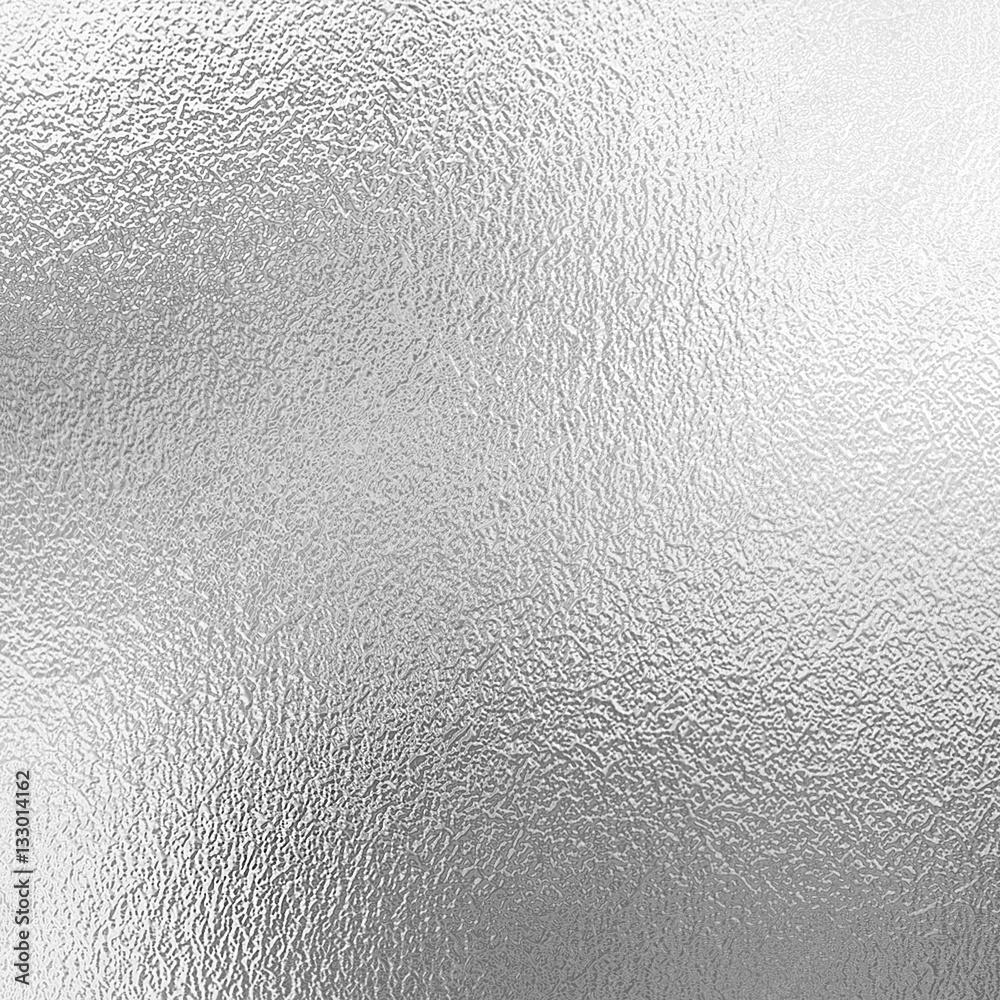


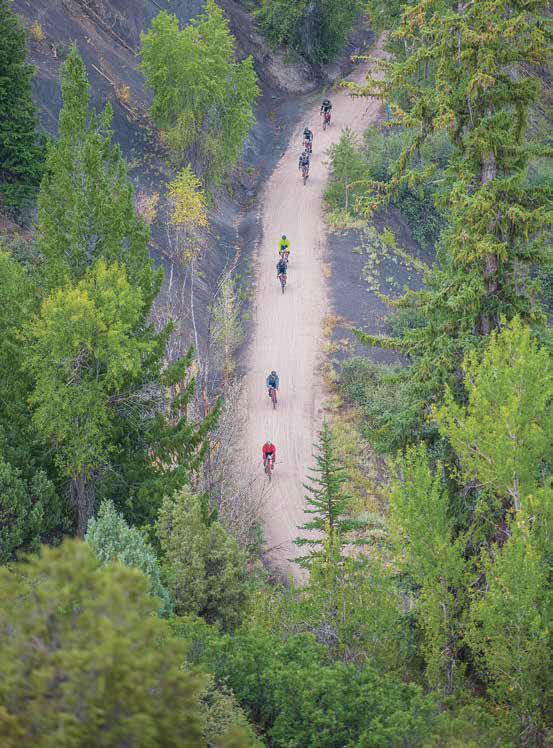

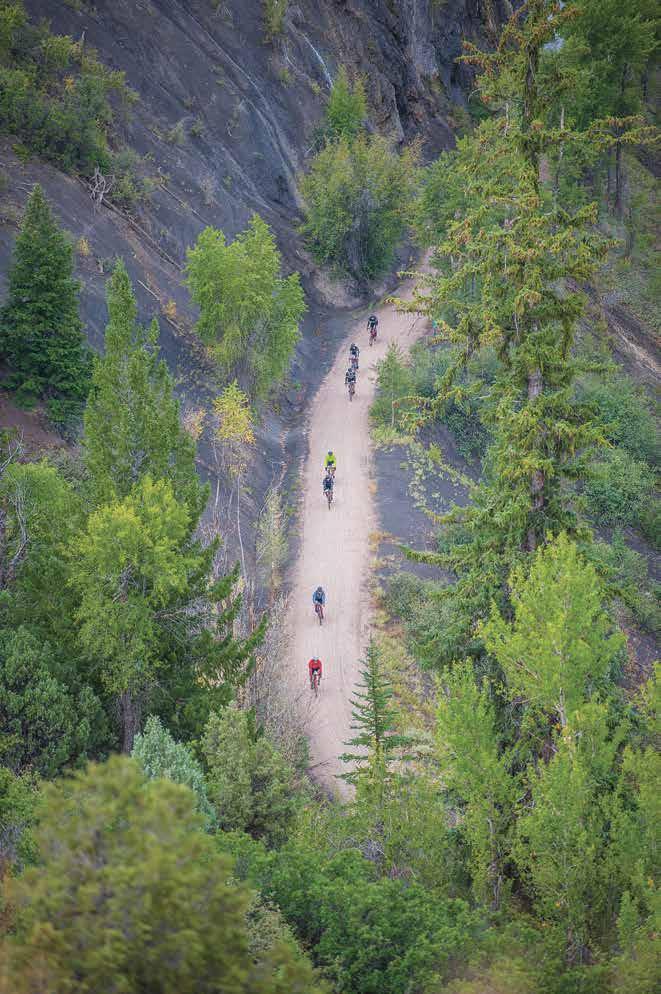
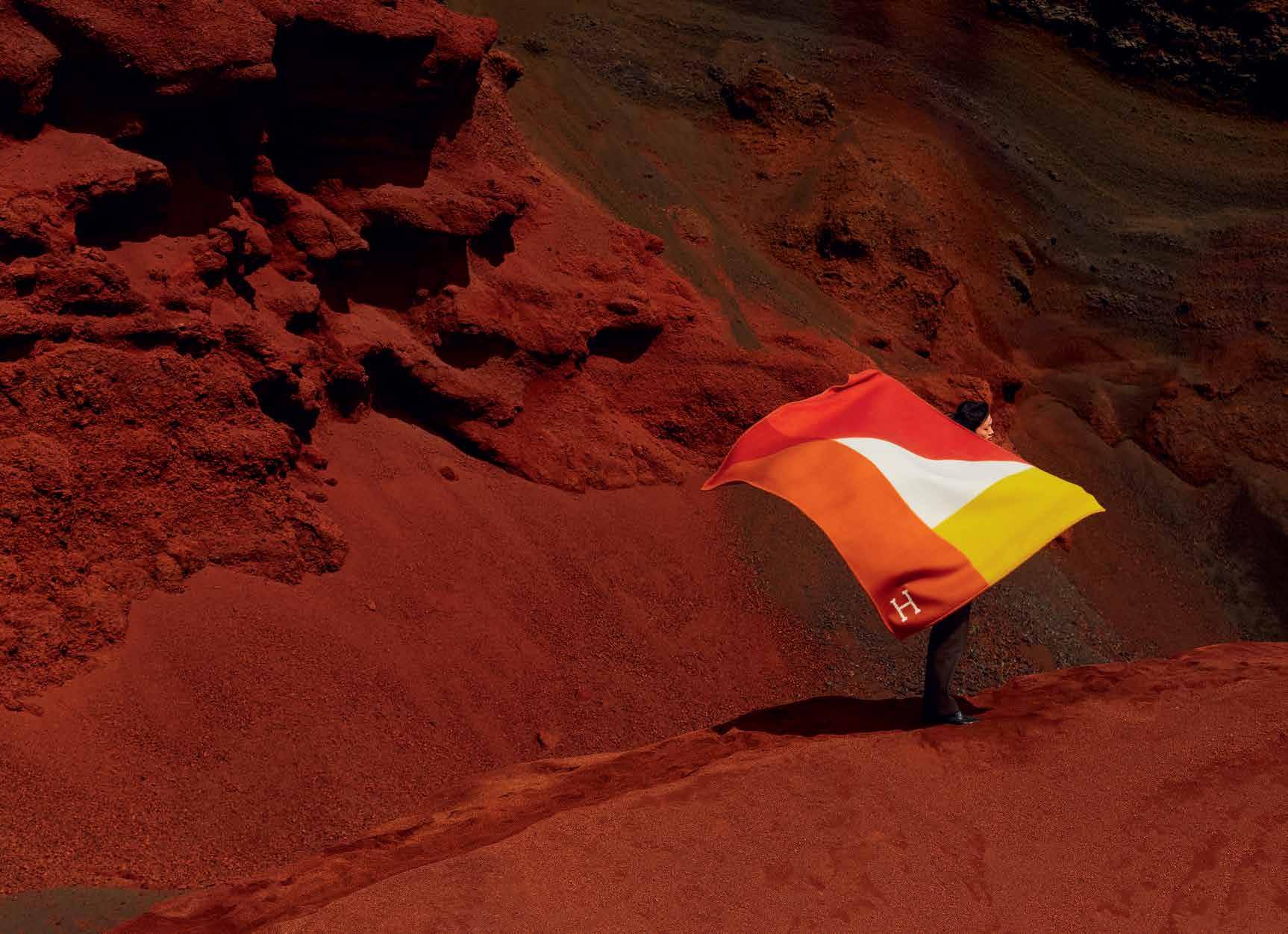

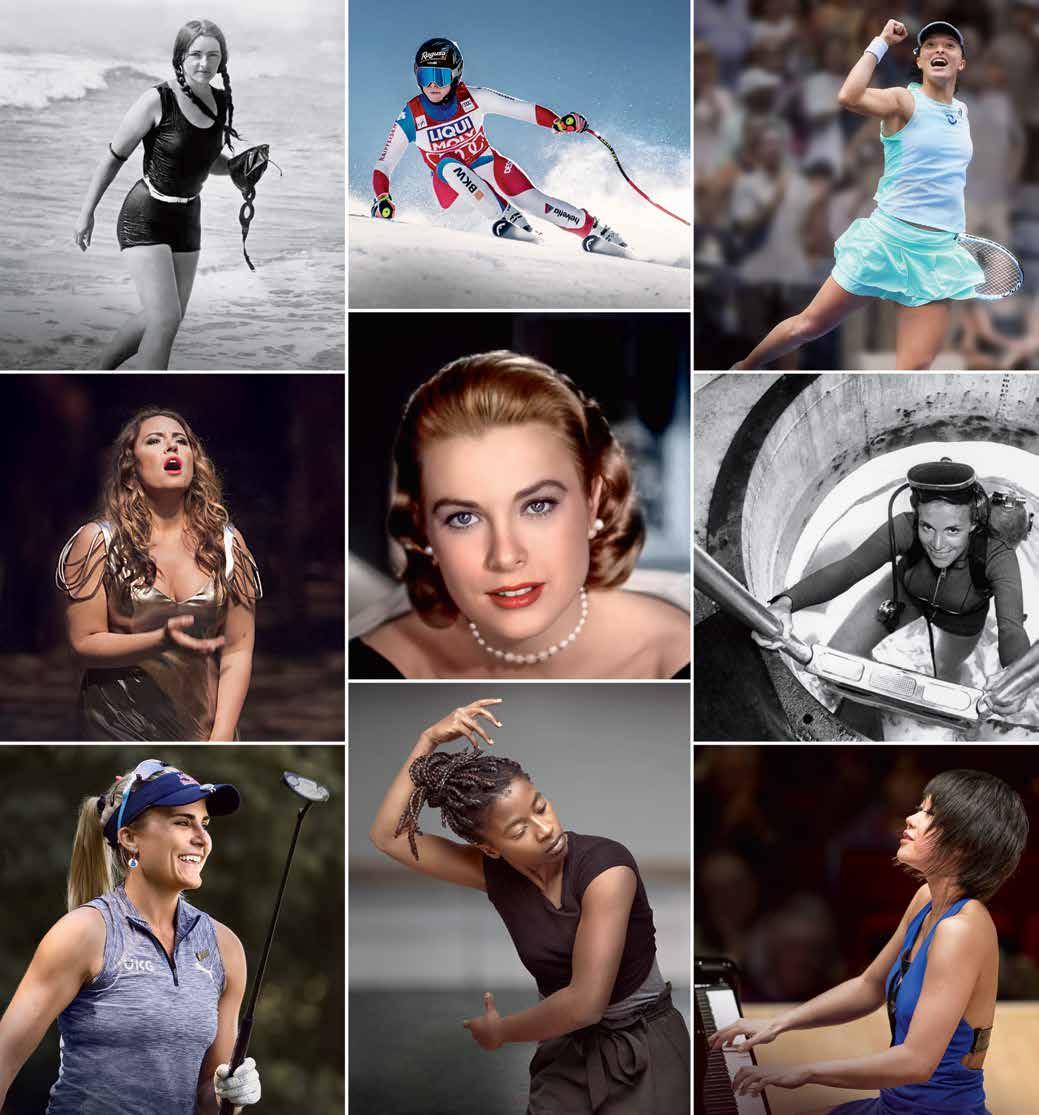








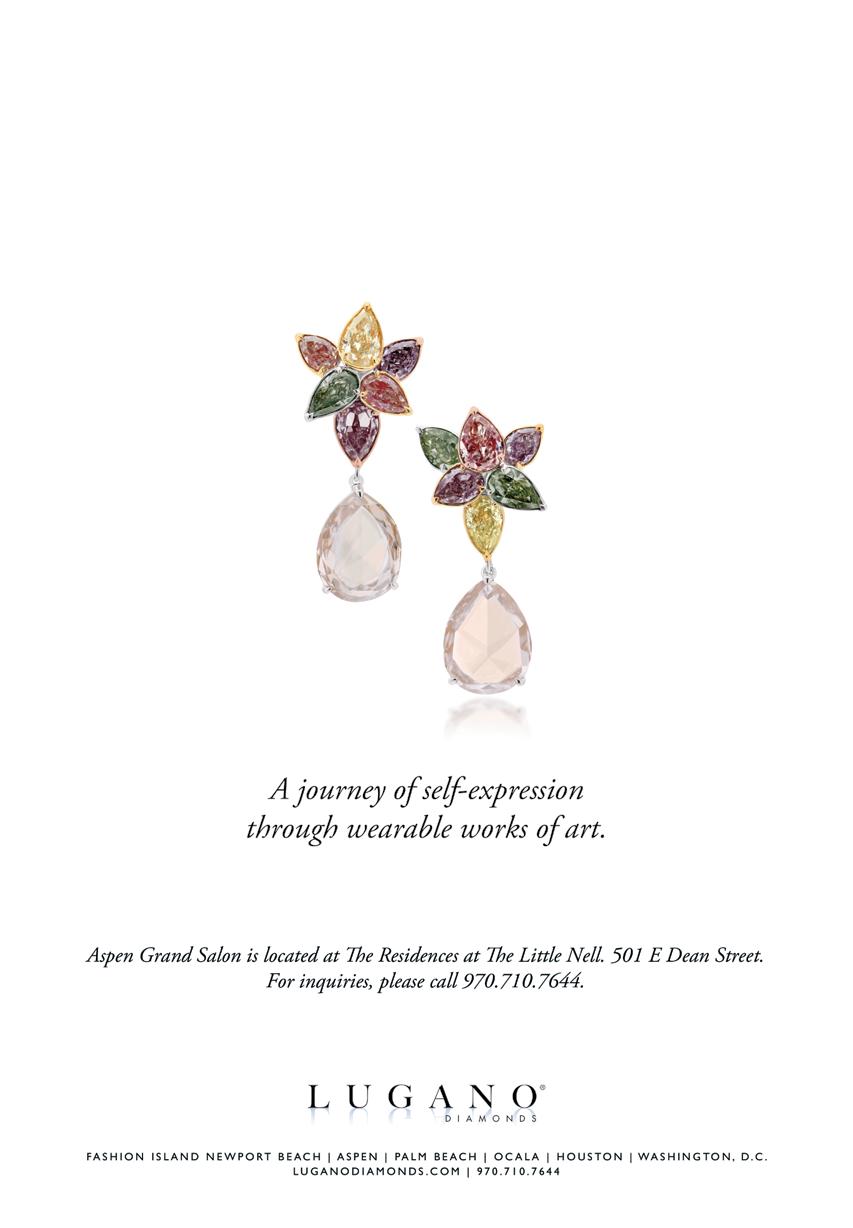














































































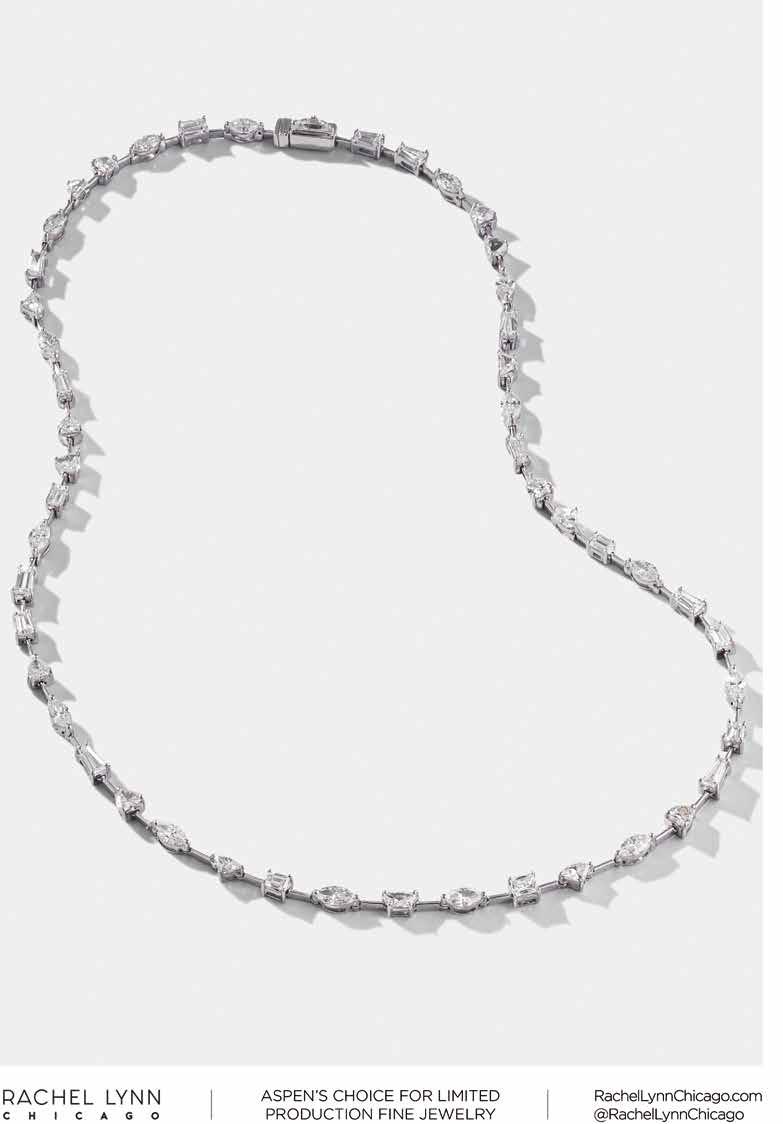
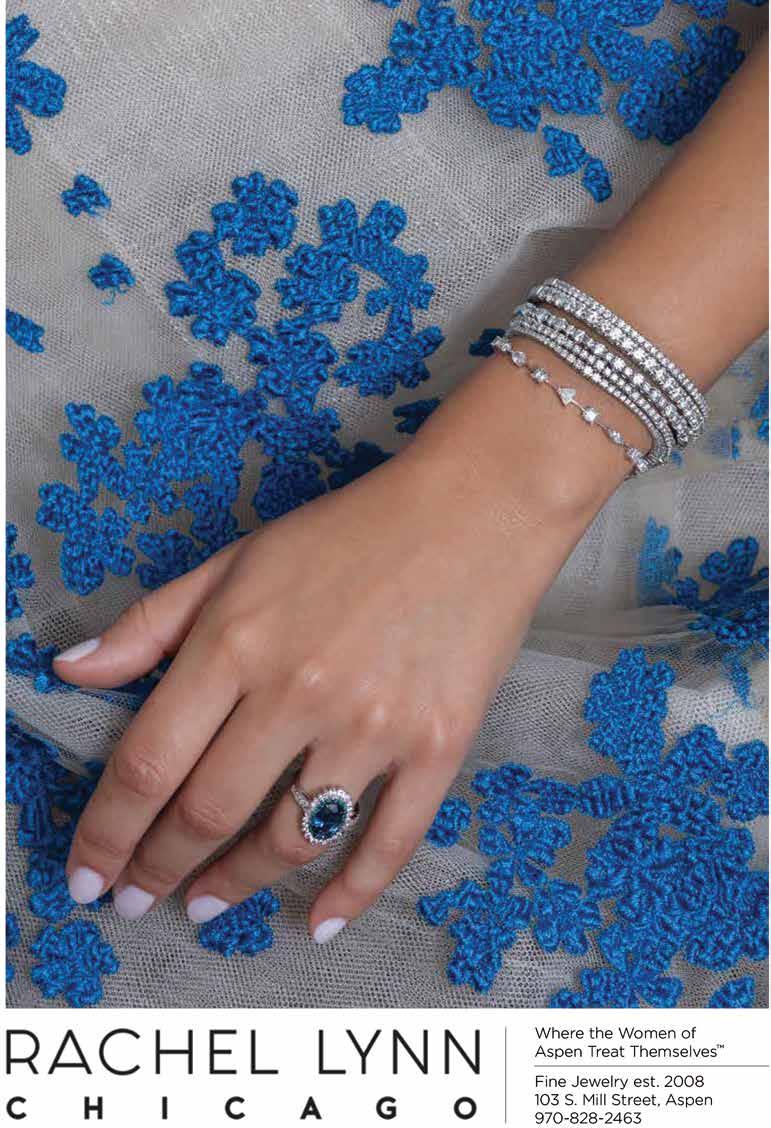

It’s safe to say that summer is my preferred time of year in Aspen, and this issue of Après highlights many of the reasons why.
I always enjoy the energy pulsating through town with the season’s many social, cultural, and thought-provoking events.
I appreciate the endless opportunities to be active and, of course, I cherish wining and dining al fresco at The Little Nell on our patios and around town.
We love to share stories from our local and extended community on these pages, such as the profile on Christian Vande Velde, a retired professional cyclist whose journey includes 10 years as our leader at The Nell’s Clip-In Cycling Camp. This year marks our 10th annual edition, which takes place from August 13 to August 17, and we invite you to sign up before it sells out.
In the food and beverage vein, we highlight Little Nell sommelier Rachael Liggett-Draper and a trio of her favorite Champagnes, as well as Casa Tua wine director Maddy Jimerson, who formerly worked at The Nell and is now a Master Sommelier. Chef Barclay Dodge, an Aspen native, 2023 James Beard Award semi-finalist, and owner of Aspen’s farmto-table restaurant Bosq, shares tips on foraging and cooking for the seasons.
Also, in the pages that follow, we highlight a handful of Aspenbased hatmakers and look at the evolution of Anderson Ranch Arts Center in Snowmass, from its history as a ceramics center to its current workings as a world-class institution with cuttingedge studio spaces and newly expanded programming for the Roaring Fork Valley’s Latinx community.
Discover the above and much more in this issue, which concludes with a tribute to Mike Kaplan, who recently wrapped a 17-year tenure at the helm of Aspen Skiing Company as CEO. Mike thoughtfully reflects on his 30-year career at SkiCo and looks forward to spending more time with his wife and family.
Warm regards,
 Henning Rahm General Manager
Henning Rahm General Manager
The Little Nell
Welcome to Aspen
10

CEO & PUBLISHER
Jason Cutinella
GLOBAL EDITORIAL DIRECTOR
Brian McManus
EDITORIAL DIRECTOR
Lauren McNally
MANAGING DESIGNER
Taylor Niimoto
DESIGNER
Eleazar Herradura
CREATIVE SERVICES
Marc Graser VP Global Brand Storytelling
Gerard Elmore VP Film
Dan Bradley VP Global Branded Video
Sheri Salmon People and Creative Services Director
ADVERTISING
Mike Wiley VP Sales mike@nmgnetwork.com
Courtney Asato Marketing & Advertising Executive
Will Forni Sales Coordinator
OPERATIONS
Joe V. Bock Corporate Affairs
Merri Gruesser VP Global Development & Strategic Operations
Sabrine Rivera Operations Director
PUBLISHED BY:
NMG Network
2023 by NMG Network, LLC. All rights reserved. No part of this publication may be reprinted without the written consent of the publisher. Opinions are solely those of the contributors and are not necessarily endorsed by NMG Network.
Masthead 12
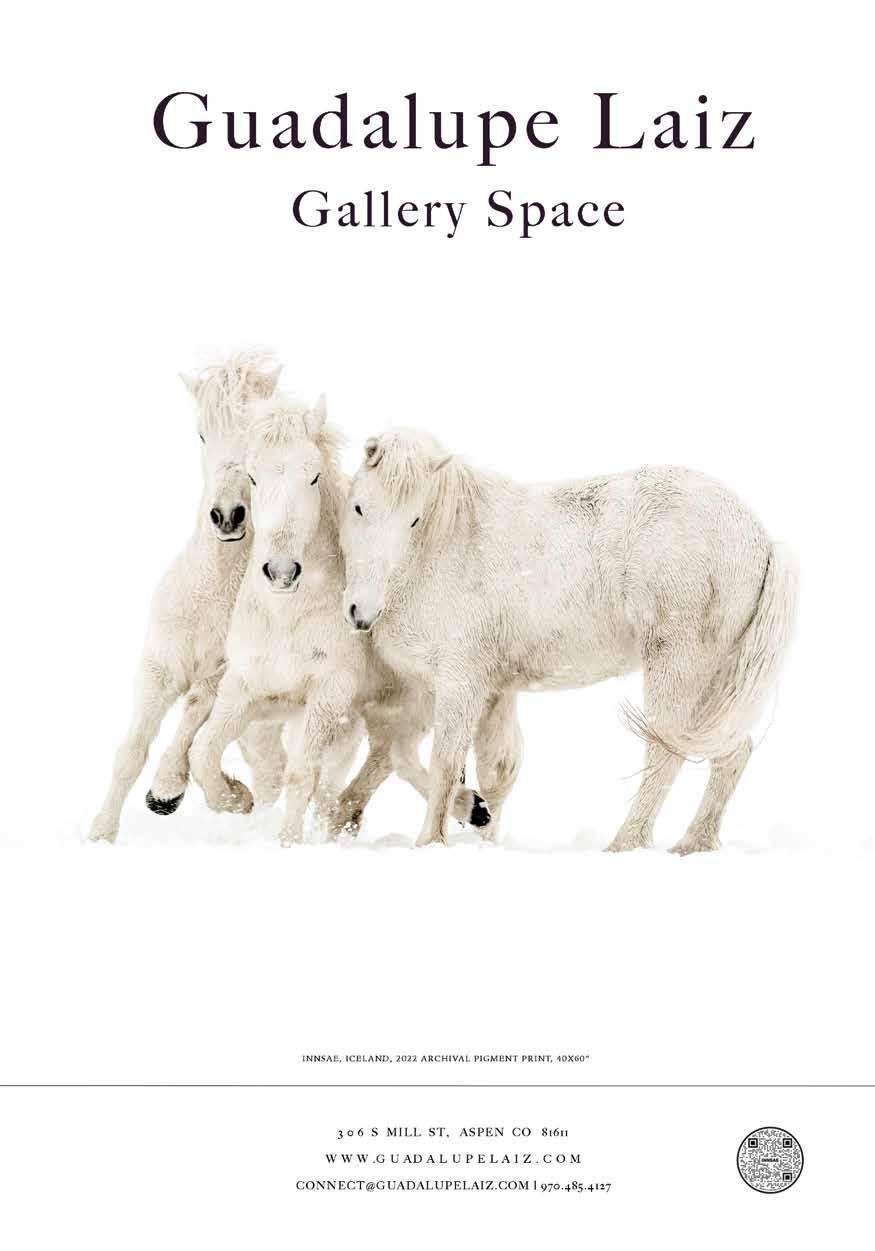

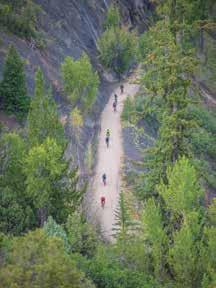
The Aviators
Meet two frequent fliers at Aspen/Pitkin County Airport, a hub for eye-catching aircraft and a vital link between Aspen and the world.
88
Bayer Was Here
A look into the work of Bauhaus artist Herbert Bayer reveals his enduring influence on Aspen’s spirit and built environment.
104
For the Love of Wine with Maddy Jimerson
Paradise Found
A pilgrimage up the Fryingpan River reveals the “hidden landscapes” of Beyul Retreat. 34
Over the Valley and Through the Woods
Foraging ingredients and sourcing from local farms, chef Barclay Dodge serves up flavors that taste of place.
Meet Your Makers
A style writer examines the origin stories behind a trio of Aspen hatmakers.
State of the Art
From humble beginnings, Anderson Ranch continues to evolve as a creative haven in the Roaring Fork Valley.
The young master sommelier describes the wine community she found upon moving to Aspen and her jaunts through Italian wine regions in the off-season.
114
Breaking Away with Christian Vande Velde
The retired pro cyclist has competed in some of the most beautiful places in the world but still believes there’s no place like Aspen in August.
124
The Allure of Aspen with Alisa Weilerstein
The cello superstar reflects on the Aspen summers that shaped her youth and her lifelong kinship with the Aspen Music Festival and School.
134 Fabulous Florals
Courtesy of Busy Beavers Gardening, The Little Nell’s summer gardens are a feast for the senses.
136
Picture Perfect
Meet Steve Goff, adventure concierge by summer, ski concierge by winter, and photographer year round.
140
A Sommelier Dreams of Bubbles
Sommelier Rachael LiggettDraper recommends singular Champagnes from The Nell’s vast wine list.
142
Summer Sips
Mixologist Andy Zurita shares one of his favorite summer cocktails from Element 47.
144
The Last Word with Mike Kaplan
Get to know former CEO Mike Kaplan, who retired in April 2023 after 17 years at the helm of Aspen Skiing Company.
Table of Contents 14
20
50
62
76
Photographer Steve Goff captures an aerial view of cyclists on a mountain trail.
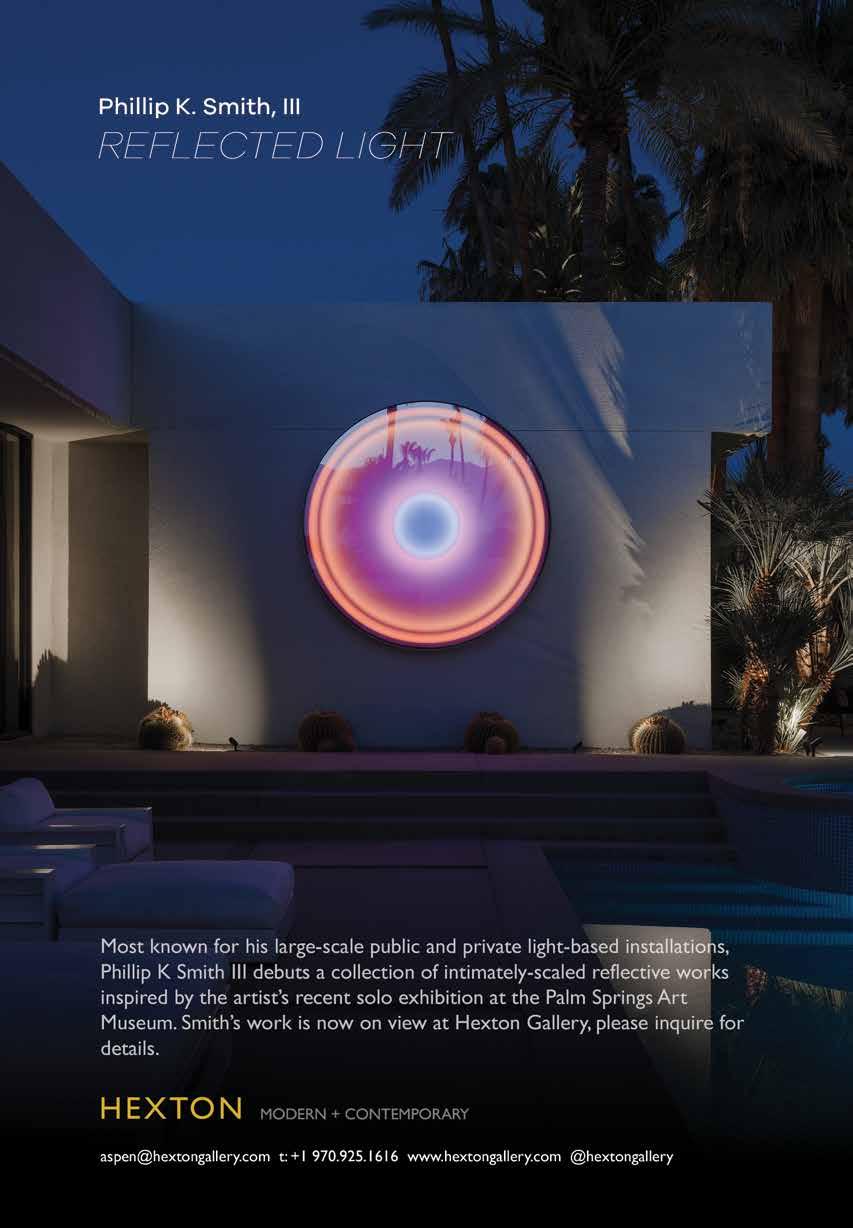
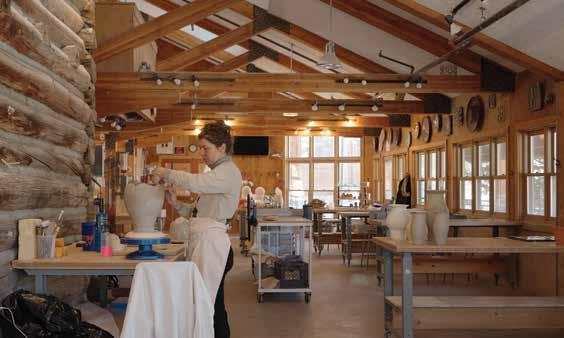
Episode 11: State of the Art
Wander the grounds at Anderson Ranch as a recent cohort of artists in residence prepare for a five-week immersion at the idyllic arts center in Snowmass Village.
For more episodes from Season 3 of Après TV, tune in to Channel 1 inroom at The Little Nell, and be on the lookout for next season of Après for more stories of Aspen and the Roaring Fork Valley.
apres.thelittlenell.com
Après TV 16
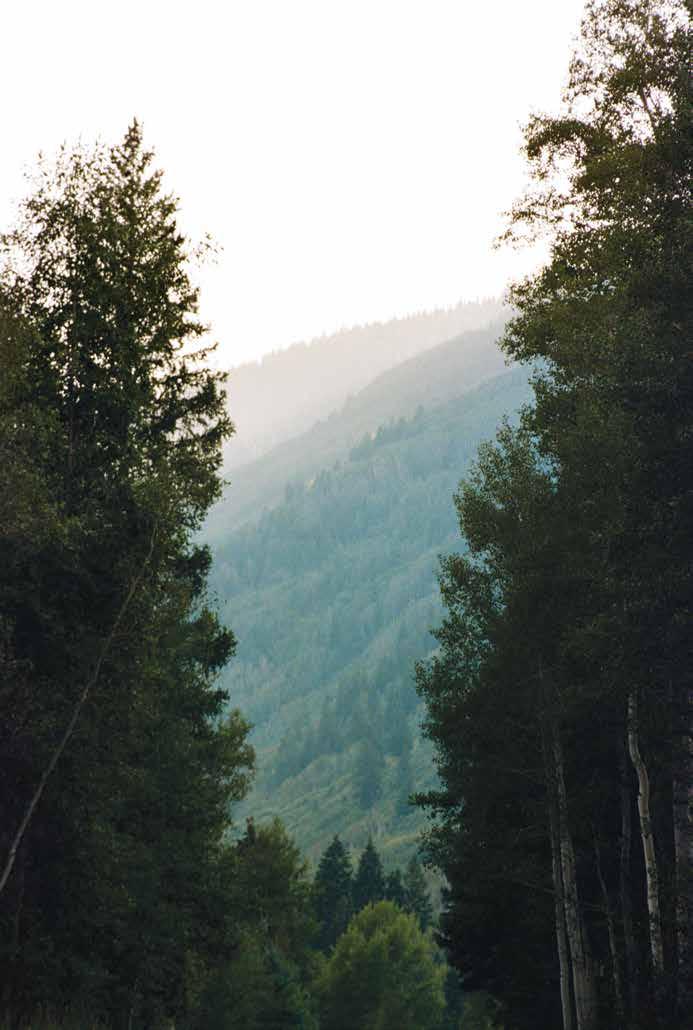
by Trevor Triano
Image
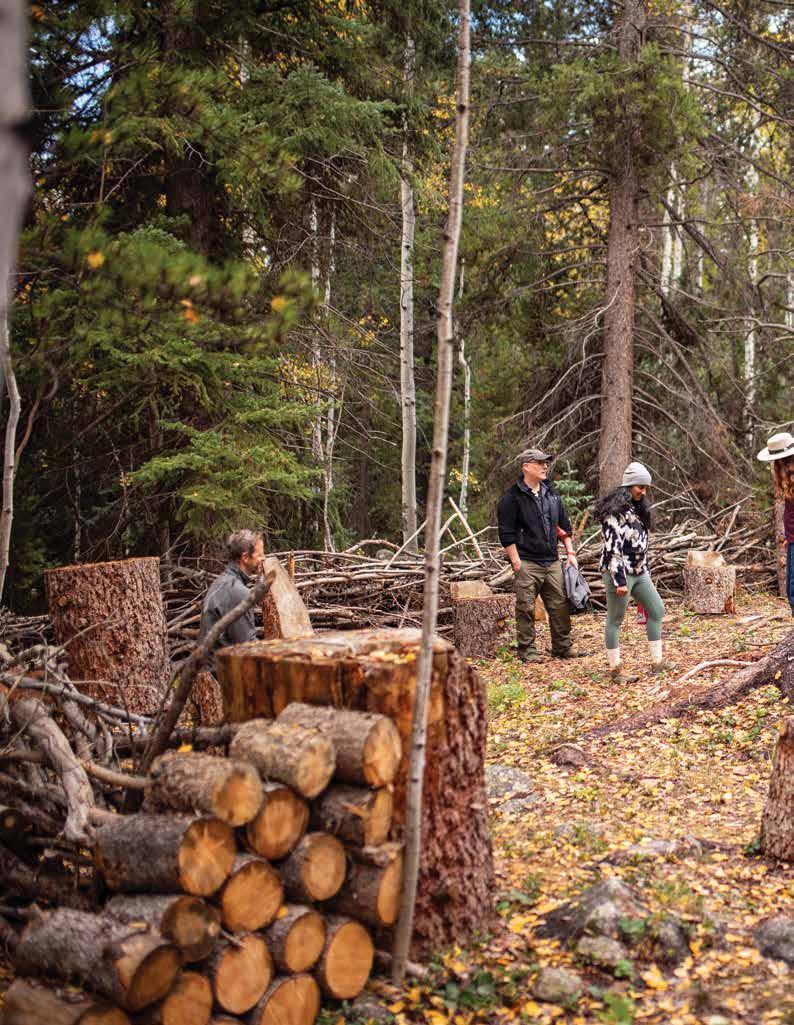 The hidden lands of Beyul Retreat.
The hidden lands of Beyul Retreat.
18
Image by Andrew Denaro
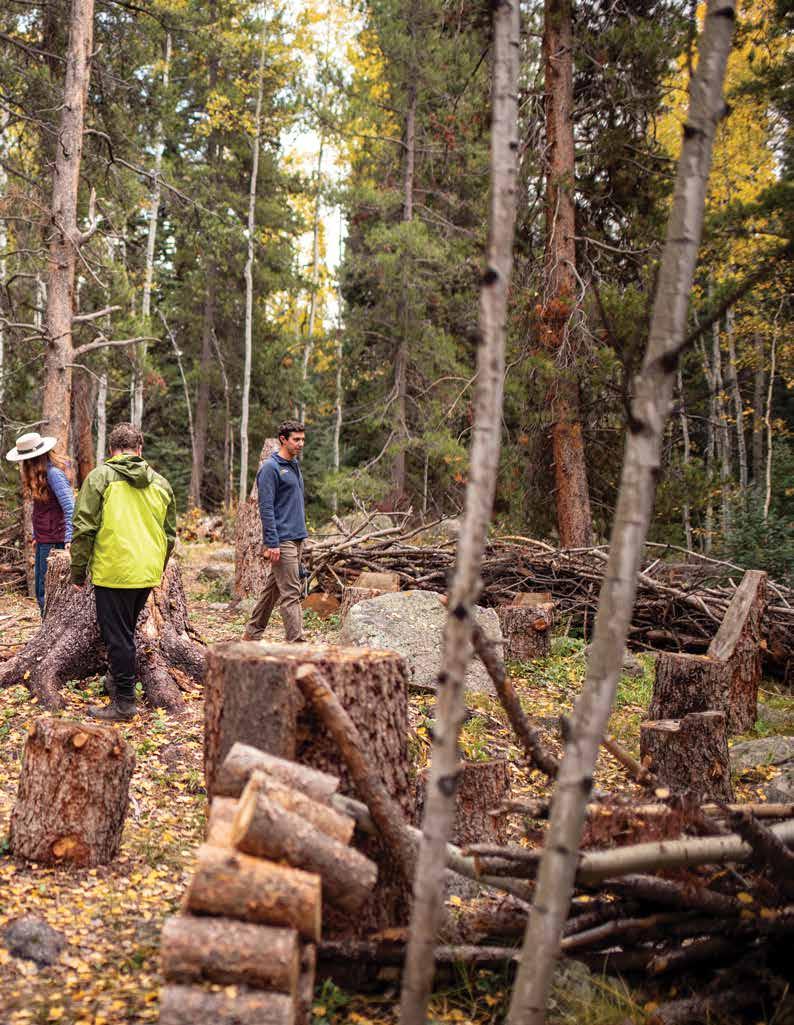
Venture
A pilgrimage up the Fryingpan River reveals the “hidden landscapes” of Beyul Retreat.
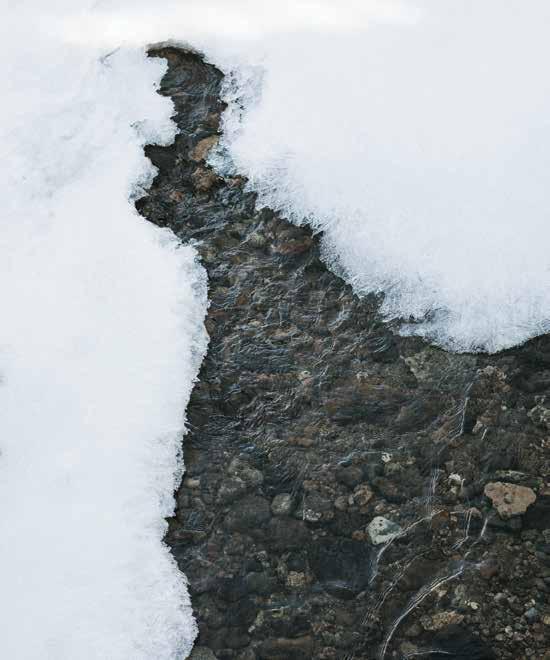 Text by Amanda Rae
Images by Alexis Ahrling, Brandon Brightside, Andy Culp, Spencer
Hansen, John Felix Shaw, Sammy Steen, and Summit Series Paradise
Text by Amanda Rae
Images by Alexis Ahrling, Brandon Brightside, Andy Culp, Spencer
Hansen, John Felix Shaw, Sammy Steen, and Summit Series Paradise
Found
20
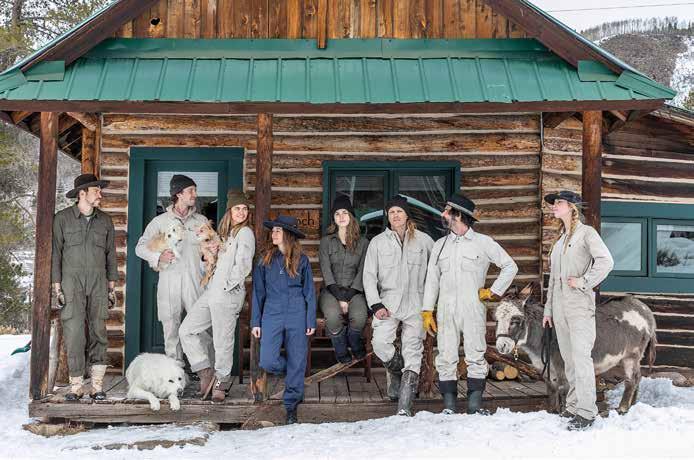
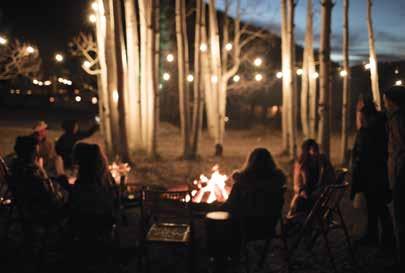
Mellow drumbeats and merry laughter fade in the alpine breeze as I stroll a dirt path along the edge of Beyul Retreat. Here beside the Fryingpan River—13 miles northeast of Aspen as the crow flies, or a hypnotic hourlong drive through Basalt past Ruedi Reservoir—a chorus of rustling blue spruce branches, cheery birdsong, and water flowing over stone surrounds the 32-acre ranch property. Despite a celebration unfolding around Beyul’s main lodge and guest cabins, my inner adventurer begs for a walk through the woods.
Beyul Retreat’s 32 forested acres are a place of refuge along the Fryingpan River.
I’m at Beyul for a friend’s birthday gathering in October. A big fan of Bluegrass Sundays on Aspen Mountain and the power of music to bring people together, he’s invited 150 friends and family members here to fulfill a lifelong dream: to host a music festival featuring bands and DJs, farm-to-table feasts, yoga, bonfires, and camaraderie amid the great outdoors. Surrounded by the White River National Forest, homeland to the Ute Indians and now a mecca for hiking, fly fishing, mountain biking, rock climbing, and paddling beyond reach of cell service, Beyul is an idyllic spot to gather one’s tribe.
It’s also a place to reflect inward. On my walk, I pass sculptures by Beyul resident artists, including Forest Spiral , a sparkling mosaic of 3,000 foraged fragments of blue, green, and clear mining-era glass suspended around a cluster of tall lodgepole pine. Forming a serene enclosure around the naturally occurring tree circle, it’s no wonder artist Lara Whitley describes it as “a listening room in the woods.”
In Tibetan, “Beyul means ‘hidden landscapes,’” says cofounder Reuben Sadowsky, an Aspen native who studied Chinese and international affairs at CU Boulder before channeling his passion for art, activism, and education into a career in event marketing and production. “It dates back to the 8th century, when Padmasambhava— sorcerer supreme who wrote The Tibetan Book of the Dead and brought Buddhism to Tibet—placed these beyul throughout the Himalaya as refuges for mankind in their time of need.”
22
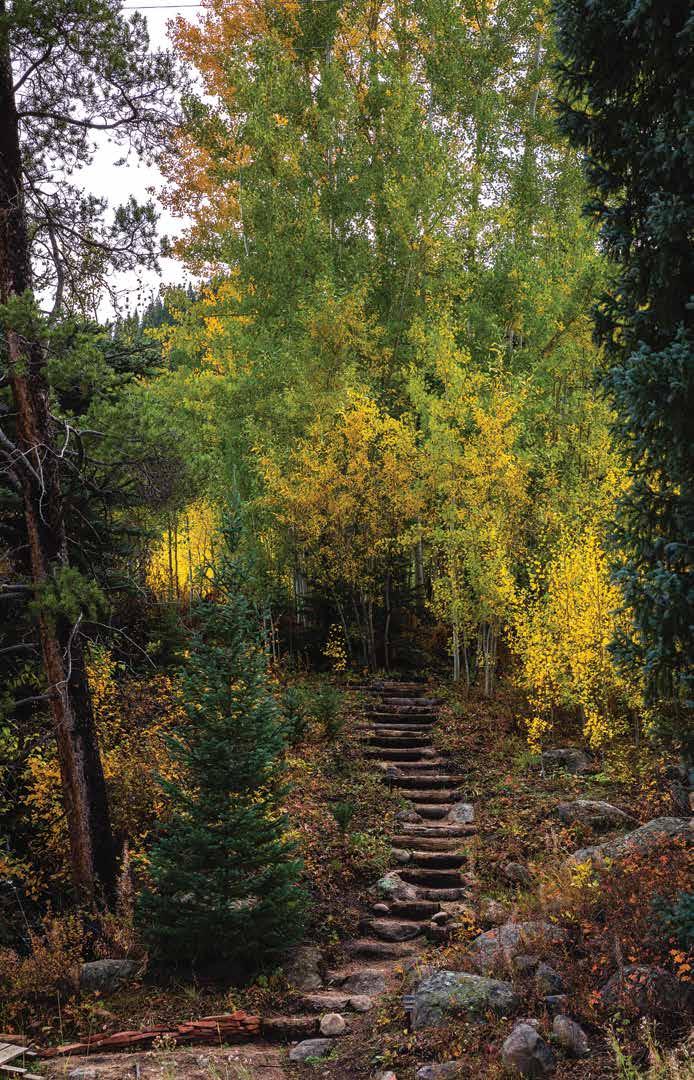

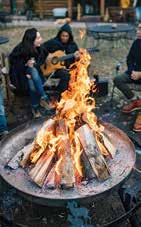
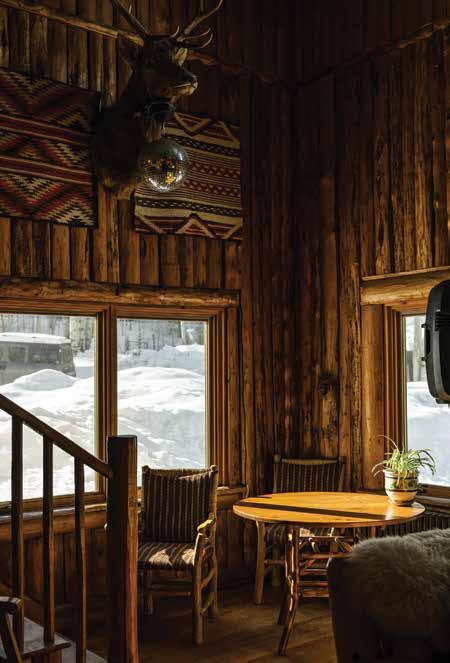
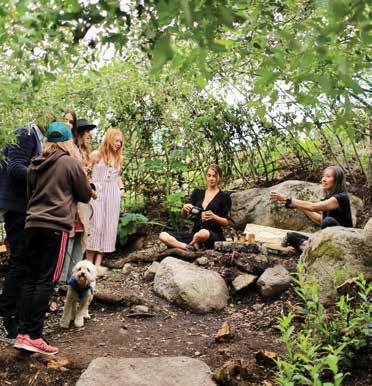
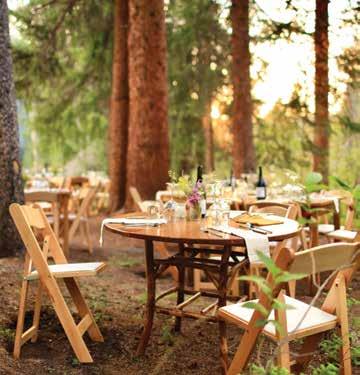
When he and cofounder Abby Stern, a yoga teacher and former executive director of Aspen’s nonprofit Lead With Love festival, discovered the plot that would become Beyul Retreat during a snowstorm in December 2019, Sadowsky immediately thought of the term and its allusions to the legends of Shangri-La, Shambhala, and the Garden of Eden. Wishing to avoid any cultural appropriation, he phoned a friend’s wife, who is Nepalese. Even before he had a chance to pose the question, “She said, ‘You should call it ‘Beyul,’” Sadowsky recalls. “‘I had a dream last night, and Guru Rinpoché [Padmasambhava] said you should do it.’”
After building a business plan, securing investors, and raising funds to purchase the historic Diamond J Ranch in November 2020, the duo set an intention: to nurture the land and share the values behind Elizabeth and Walter Paepcke’s “Aspen Idea”—that a “community of peace” can be achieved through fitness of the mind, body, and spirit in equal measure. (Soon after my friend hosted Sababa Fest on the grounds of Beyul, he was offered his dream job as Aspen community
programs coordinator at the Aspen Institute—birthplace of the Aspen Idea.)
“It sounds kind of woo-woo, but the magic of putting intention into the land is already showing up in a big way. This has been the most water-rich last couple of summers and winters in a decade,” Sadowsky says. “The mushroom harvest has been out of control! This property has gotten much greener since we’ve gotten here.”
Beyul has also evolved to encourage exploration thanks to property director James Gorman’s tireless constructions— an entrance bridge, cedar sauna, and 1,500-square-foot event barn, among others—as well as robust volunteer efforts. Colorado’s State Wildland Inmate Fire Team (SWIFT), composed of skilled laborers serving prison time, completed large-scale landscaping, fire mitigation, and trail building over six days. “It was a big deal that they got to stay up here,” Sadowsky notes, “and they found it to be a healing experience.” (Unknowingly, I had admired the squad’s chainsawed wooden sculptures during my nature walk in October.)
26

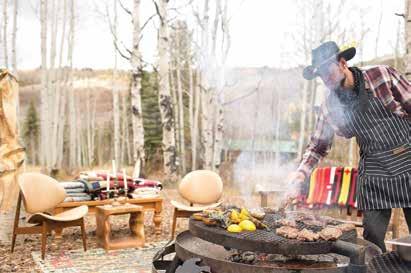
Historically, the area has always attracted settlers. The dilapidated barn at Beyul’s entrance, in fact, served as a ticket office for the first railroad to cross the Continental Divide, from Leadville through Hagerman Pass to Glenwood Springs and Grand Junction beyond. (It was decommissioned shortly after.) Located at the confluence of the Fryingpan and North Fork rivers, in the Muckewanigo (“bear crossing” in Native Ute dialect) drainage, Beyul sits on an ancient freshwater seabed rich in hematite.
“When hematite, a magnetic mineral, hits air and oxidizes, and we have the tectonic plates [shifting], that’s what gives us that unique maroon formation indicative of our area, the Maroon Bells and [the scenery] when you drive up the Fryingpan,” Sadowsky says. “There’s a lot of charge in the mountains here.”
I return to Beyul in mid-November for Ranchgiving, an end-of-season ticketed bash. My group rents the original 1920s Longbranch cabin, which sleeps eight. In the kitchen we prepare dishes for the

HIDING IN PLAIN SIGHT
The most coveted listings are often hiding. Call me, I know how to get the keys to all the hidden doors.
STEPHANIE LEWIS | Luxury Aspen Broker | 970.948.7219
Thanksgiving-style potluck, followed by dancing to jazzy South African amapiano house music in the music tent and main lodge. Once again, I opt out of connecting to the main lodge’s Wi-Fi, going dark on phone, email, and social media for a restorative 48 hours. Instead, I escape to the cedar sauna and cold plunge post-dance party and revel beneath an inky, star-dappled sky.
“I feel like beyul—places for ideas, and people to rejuvenate, regenerate, and figure out new things for the betterment of mankind—are not just places to be found, but places to be created,” says Sadowsky, who lives nearby in Meredith. His morning routine is utopian: an early run (or cross-country ski, in winter) with his wolf dog, Atlas, followed by hot-cold therapy (a brisk river dip in warmer months), meditation, journaling, and
quigong before a daily team meeting over tea and coffee.
Half of Beyul’s staff lives on site, lending personal touches to events— more than 110, including 30 concerts, to date. Upcoming on my radar: a silent meditation workshop, dream yoga, a gravel biking camp, guided mushroom foraging with expert mycologists, and next winter’s thirdannual outdoor wellness retreat, plus ceramics, weaving, and woodworking classes in Beyul’s new maker space and a weekend dinner series featuring Colorado produce. “We’re gonna go Francis Mallmann … cooking over campfire,” says executive chef Greg Ashbaugh, citing the Argentine chef and Chef’s Table star as inspiration.
“I think we represent an older generation of Aspen: the creative, introspective,
30

With its wild solitude and vibrant offerings designed to enrich mind, body, and spirit, Beyul Retreat was envisioned to be, as cofounder Reuben Sadowsky puts it, “the Esalen of the Rockies.”
athletic, communal archetype that’s been around here a long time,”
Sadowsky says, adding that his grandmother and parents (Alexandra Halperin, Aspen Mountain’s first female ski patroller, and Dan “Pastor Mustard” Sadowsky, a KDNK Radio host for 17 years and emcee of the Telluride Bluegrass Festival for nearly three decades) embody that standard.
“A lot of people who come to Aspen only discover what’s in a six-block radius,” Sadowsky continues. “Us holding down this corner and making something cool, mysterious, a little bit sexy, and fun is a hook to show the real value of this area. To have a transformational experience … you might have to go past the roundabout.”
32

Aspen | Snowmass Avon | Eagle | Vail Carbondale | Basalt Crested Butte Denver Tech Center Glenwood Springs | Rifle www.garfieldhecht.com | 970.925.1936 ph. | atty@garfieldhecht.com A Litigation and Transactional Law Firm Experts at Traversing the Legal Landscape Let Us Guide You Garfield & Hecht ATTORNEYS AT LAW | SINCE 1975
Foraging ingredients and sourcing from local farms, chef Barclay Dodge serves up flavors that taste of place.
With the arrival of summer in the Roaring Fork Valley, nature sets out an inspired tasting menu. There’s the blossoming of the lilac and its heady scent; the blooming of dandelion flowers; the brief window when blue spruce trees put forth their tender tips. These essences of Aspen’s seasons have come to define the flow and taste of Barclay Dodge’s life as chef of the restaurant Bosq, which he owns with his wife, Molly Dodge.
word for “forest.”
gets its name from the
Dodge’s Aspen restaurant, Bosq,
Spanish
Text by Anna Harmon Images by Trevor Triano
Over the Valley and Through the Woods
34

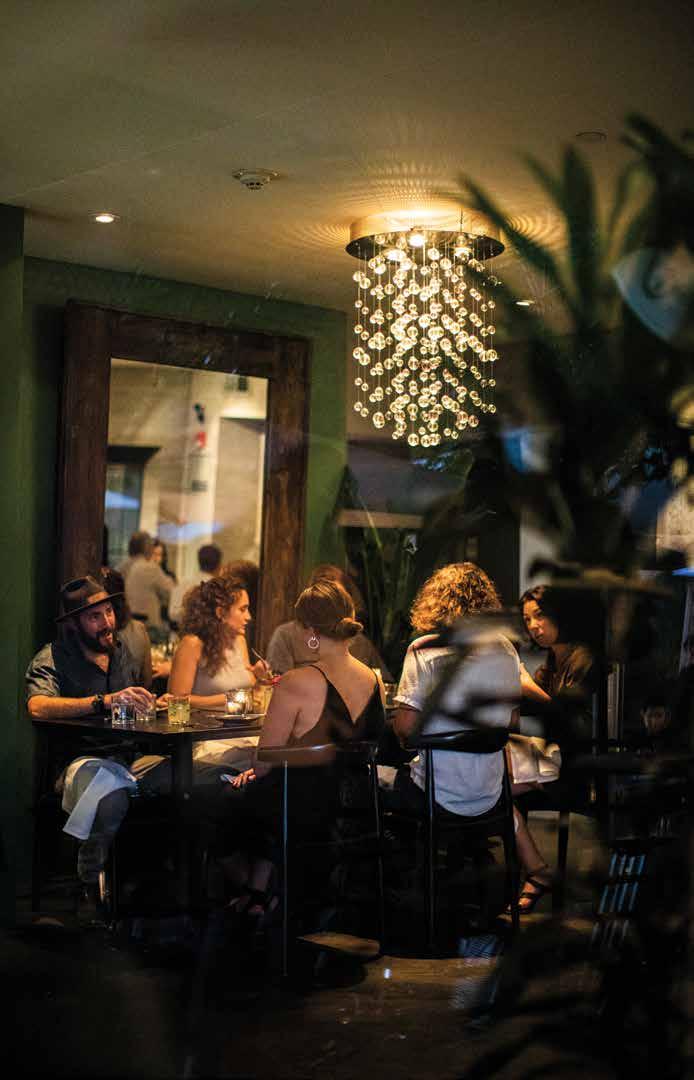

Chef Barclay Dodge opened Bosq seven years ago, but he feels the restaurant’s identity really came to fruition around four years ago with its celebration of hyperlocal ingredients.
“Summertime is an explosion,” he says. “I always preach to my cooks, I want this exploding out of the plate. If you think it’s too much going on, then do more—I want you to feel the life of summer.” On plates they spread thin slices of yellow heirloom tomatoes, top summer melon with bee pollen and watercress, place apricots soaked in dandelion syrup.
Nearly every day, Dodge wakes around 6:30 a.m. and drives up Independence Pass—one of his favorite places—to forage ingredients. He has destinations bookmarked in his head, none of which involve trailheads or commonly traversed paths. He’ll pull over and head into the woods to where he has come to expect the ingredients he loves. Yearly, he returns to the same mile-long watercress patch growing along a burbling stream that feeds into the Roaring Fork River. He found it in the early 2000s, and he has never seen signs of another person there.
The chef has been foraging in the area since the late 1990s, after tagging along with a mushroom forager who sold to a restaurant where he worked. “He introduced me to the ability to see around you and to find zones when you’re foraging,” he says. Now, Dodge can sense if he’s in the right spot for a mushroom based on cues in the grass, soil, sunlight, and tree cover.
38
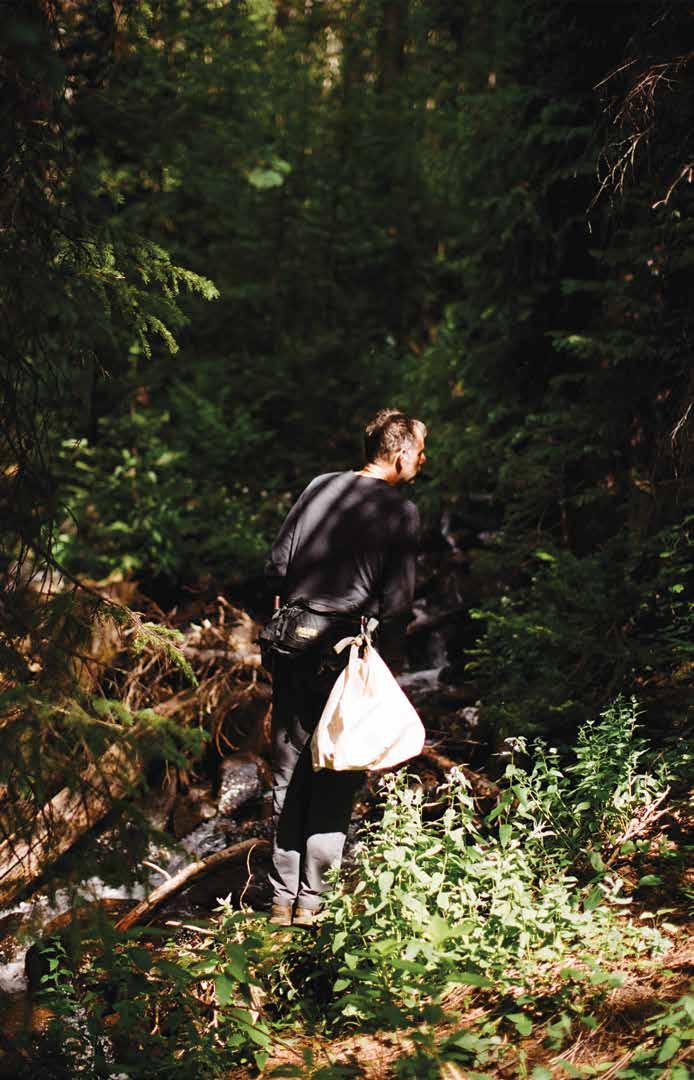
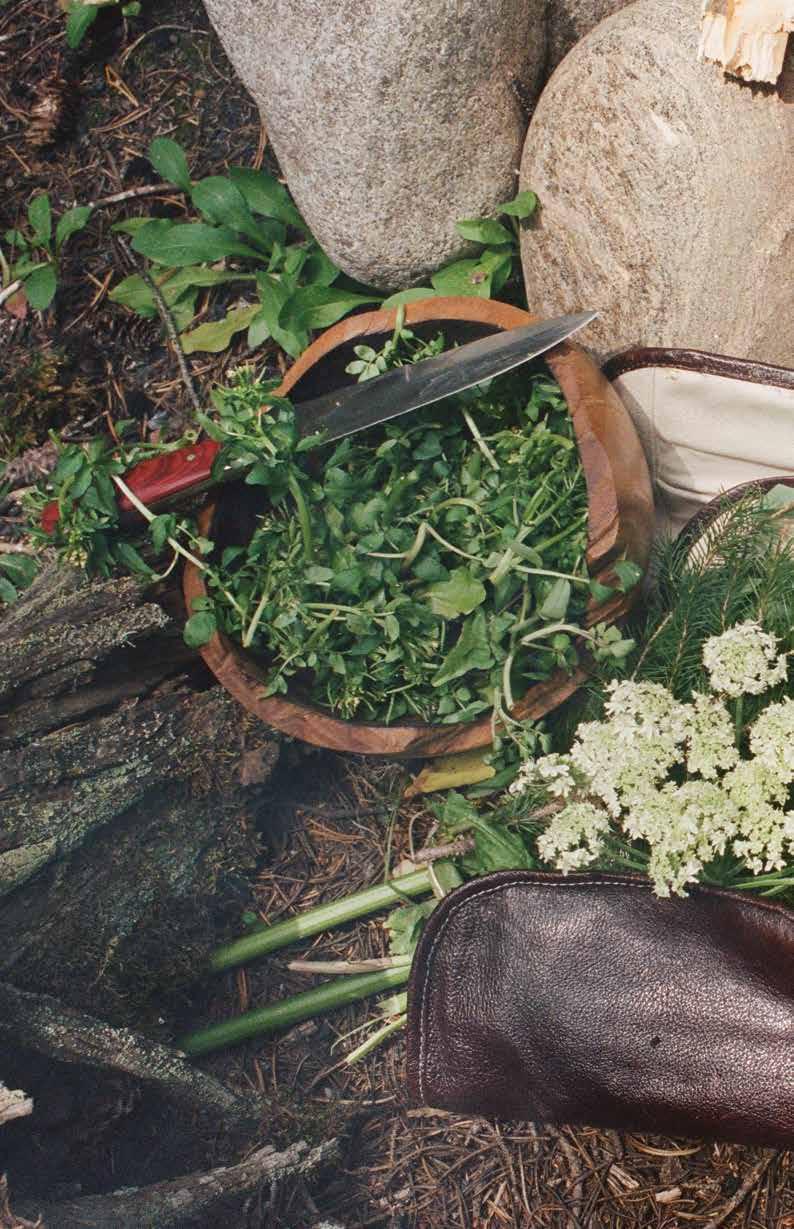
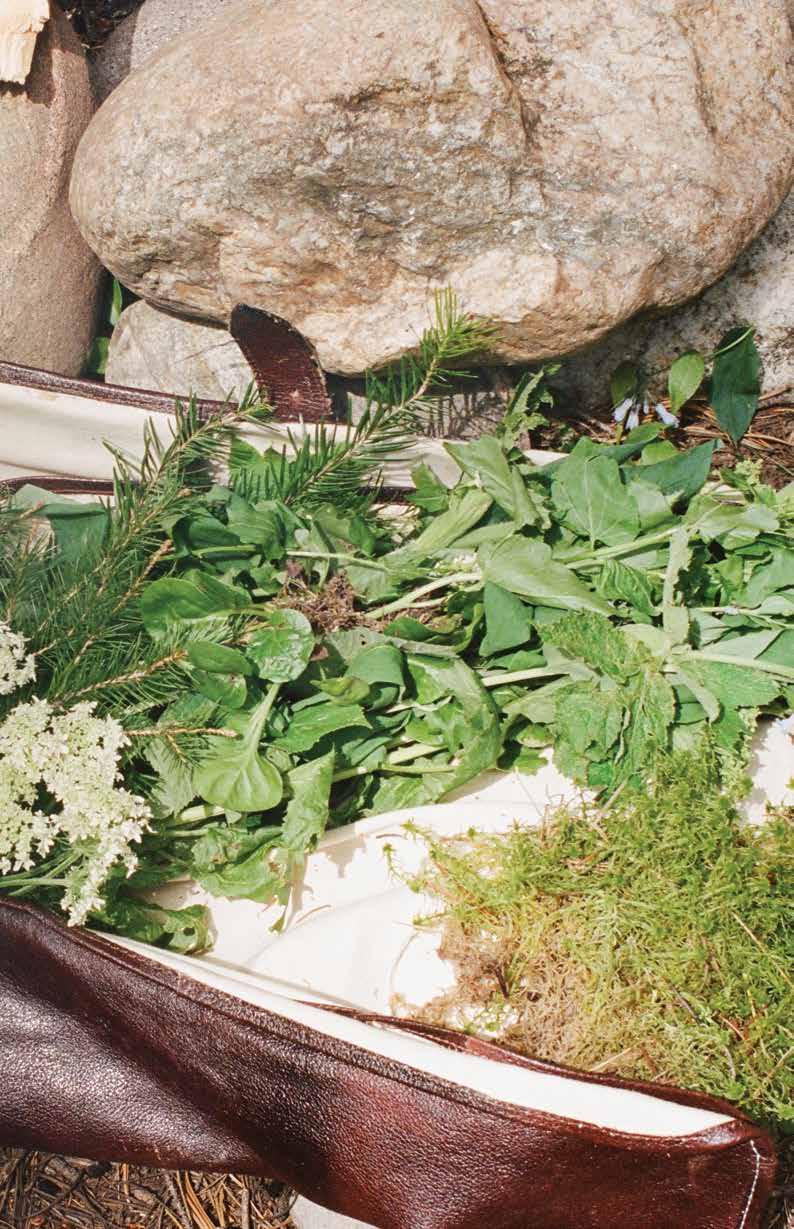
Dodge got his first restaurant job as a teen in Aspen. He had moved there in 1983 at 13 years old with family, and when he needed a summer job in high school, there were limited options: construction, retail, or restaurants. The thrill of walking home with $100 cash tips in his pocket from bussing tables sold him on the industry. While he wasn’t thinking about local ingredients then, they had been part of his upbringing back in Alabama: His great-grandmother sourced locally, catching frogs in her backyard to fry up, for instance, as someone from a resource-strapped small town had to do in her era. She also had signature dishes, like her brownies that came out of the freezer. To him, she had the touch of a true cook.
He went on to travel the world, from Mexico to Spain, to experience new cultures and work at acclaimed restaurants such as El Bulli, which has informed the way he thinks about flavors and techniques. But Dodge came back to Aspen for family, the beautiful surroundings, and the opportunity to serve clientele at a high level while still being able to close Bosq in the off-seasons to spend time with family and gain new experiences. (He encourages his chefs to stage at other restaurants when Bosq is closed, and this fall, he is taking the team to Oaxaca for inspiration.)
In the summer, what Dodge and his team forage and source largely
defines the evolving menu. Dodge makes weekly buys from what he calls the “Green Belt,” a valley dense with farms and ranches about two hours away, through a company called Farm Runners. He also visits farms in the valley between Aspen and Glenwood Springs, including the biodynamic ranch Sustainable Settings near Carbondale, where he’s become close friends with the owner. He knows summer is in full swing around July 4, when local produce surges from asparagus and some stone fruit to a bounty of options. Unlike a lot of chefs, Dodge is also eager to change up his ingredients. A farmer from about 20 miles away once told one of his cooks he had duck eggs, so they bought 48 and featured them on the menu for four days.
Summer lingers into October in the Roaring Fork Valley, supplying an abundance of tomatoes and mushrooms even as the days get shorter. But then, Dodge says, “You’ll see one aspen tree turn gold and you’re like, summer’s over.”
The first frost is a hard stop. The stream of produce slows to a trickle, and the mushrooms are gone. The trees thrill in their autumnal hues. Bosq closes for the fall off-season before reopening in December, leaning into what the body craves in the cold months and embracing the stark aesthetic of six feet of snow on the ground. But throughout the year, the taste of summer lingers on the tongue in the preserved essence of plums and spruce tips.
42
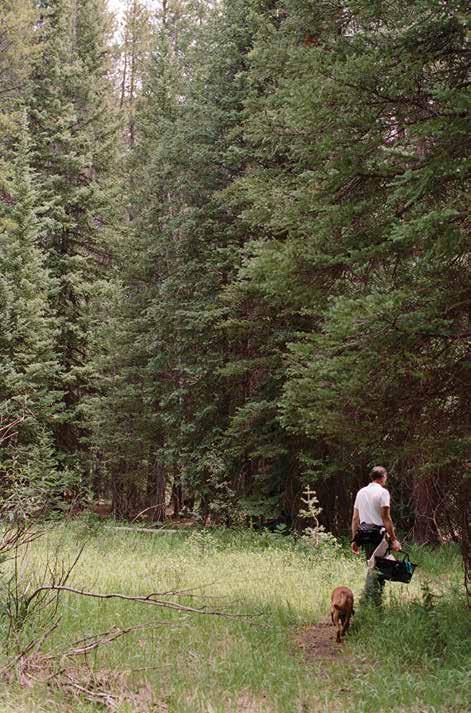
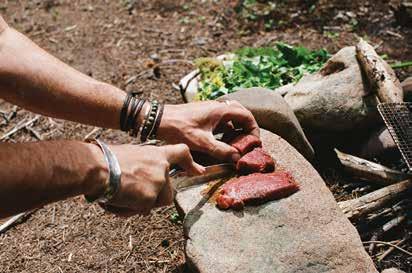
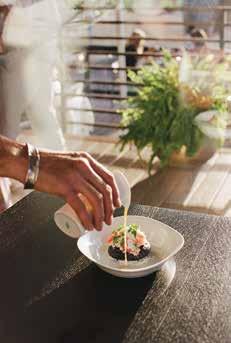
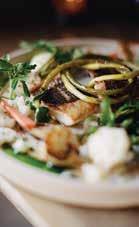

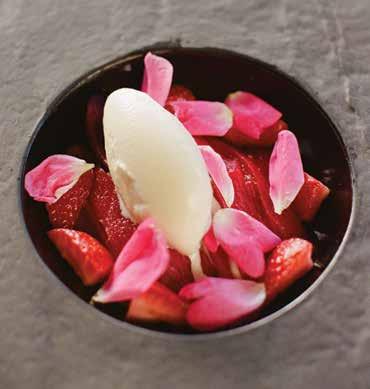

Field Notes from Chef Barclay Dodge
Experiment with fresh, local ingredients.
“If a farmer brings me a one-gallon Ziploc bag of something, I'll change the menu for two days to use it,” Dodge says.
Cook what you can forage.
Dodge finds that wild ingredients have more intense flavors than farmed ones. He recommends novice foragers bring a book—or, even better, an expert—with them. Compare what you’ve found with pictures, and if you’re still not certain you’ve identified the ingredient, take it to a reliable resource to confirm. When he was learning about local ingredients, Dodge once briefly misidentified hemlock as osha (bear’s root), a mistake he is certain to not make again. These days he also enjoys the company of Colorado foragers who connect over Instagram and discuss their findings.
Respect your resources.
Hiking along a stream one summer in search of green pine cones, Dodge came across a dammed pool that was flush with them. As he started harvesting the cones, squirrels in the tree above started chattering violently, and he realized he had stumbled upon their winter haul. “So I took a few and left the rest,” he says.
Find ways to use local produce year round.
Spruce tips are only abundant for about three weeks of the year, but Dodge celebrates their essence all year by freezing them, making syrups and oils, and using them to preserve other ingredients like venison heart. To make his pine tip syrup, a take on mugolio, combine half spruce tips to raw sugar, put it in a jar with a rock on top to compress it all, and leave it for two months to allow the sugar to pull the moisture from the spruce tips.
Listen to what your body craves as seasons change.
Dodge has found he enjoys plums in winter. “We put plums up in all kinds of ways—umeboshi, lactose fermentation, syrups, vinegars. … There’s something about red in the winter that I really gravitate towards. Pigment definitely has a flavor and a feel,” he says. “Over the course of the winter, we realize what our bodies are telling us, what we feel like using.”
46
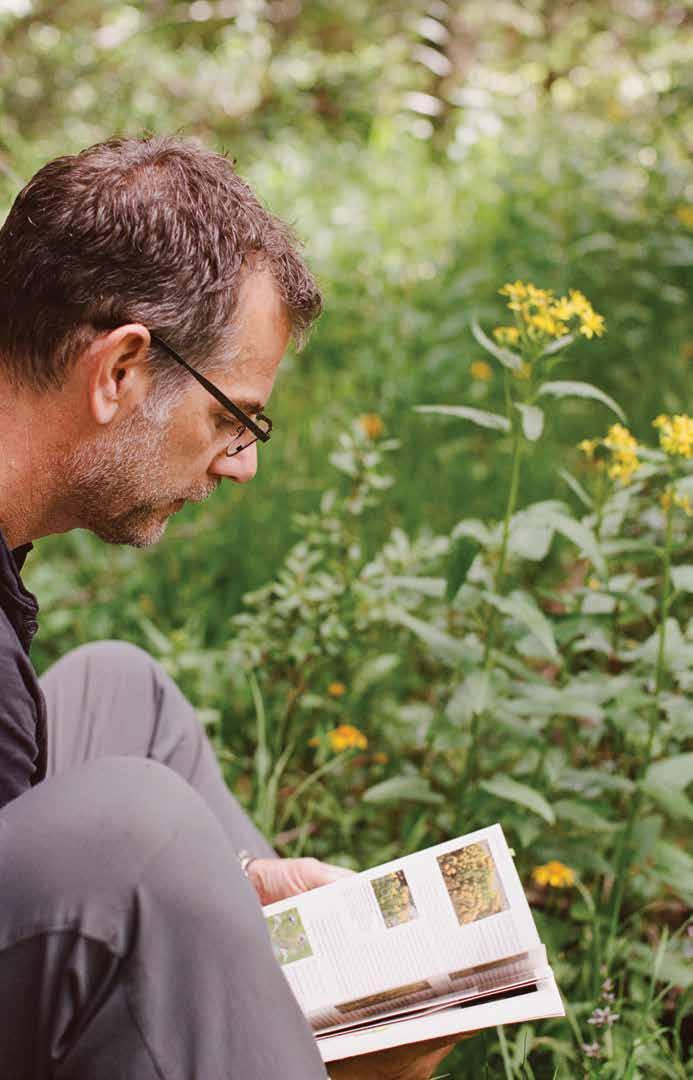
 Nick Fouquet’s tools of the trade.
Nick Fouquet’s tools of the trade.
48
Image by Martina Albertazzi
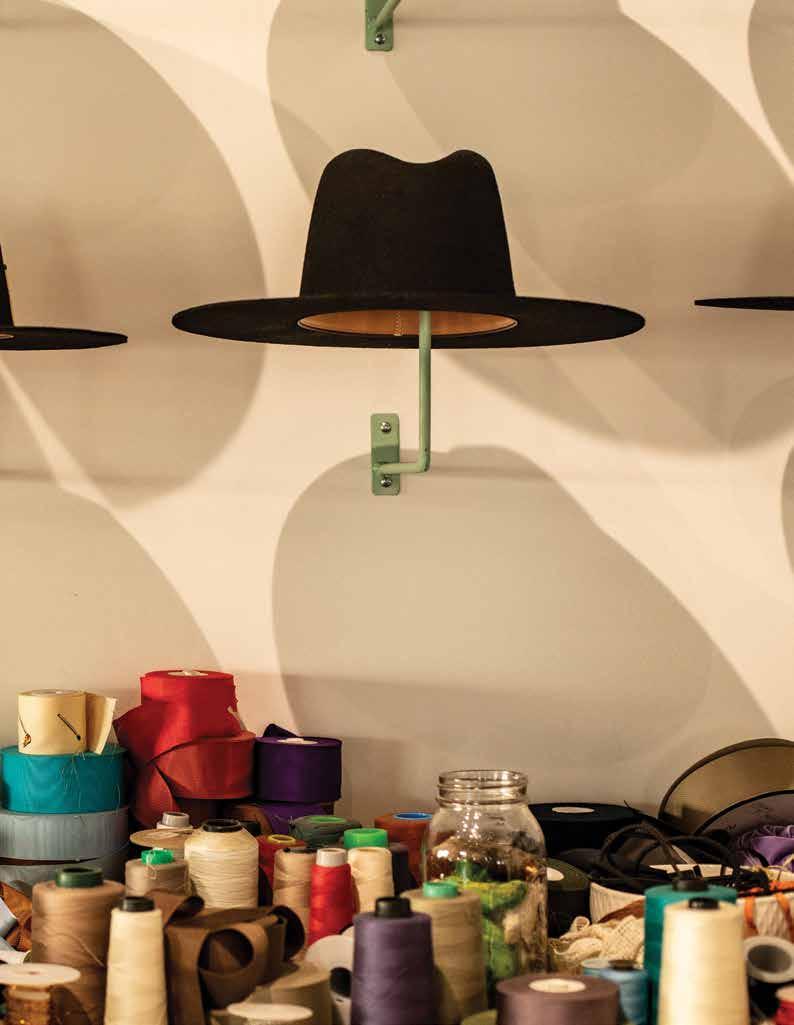
Savor
A style writer examines the origin stories behind a trio of Aspen hatmakers.
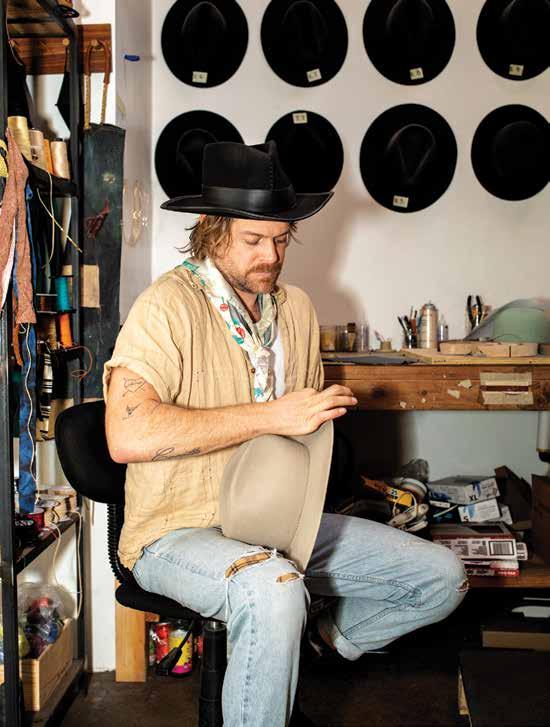 Text by Katie Shapiro
Text by Katie Shapiro
Meet Your Makers 50
Images by Martina Albertazzi, Lindsey Childs, Olive & West Photography, Anna Stonehouse, and Stephanie Weinreis
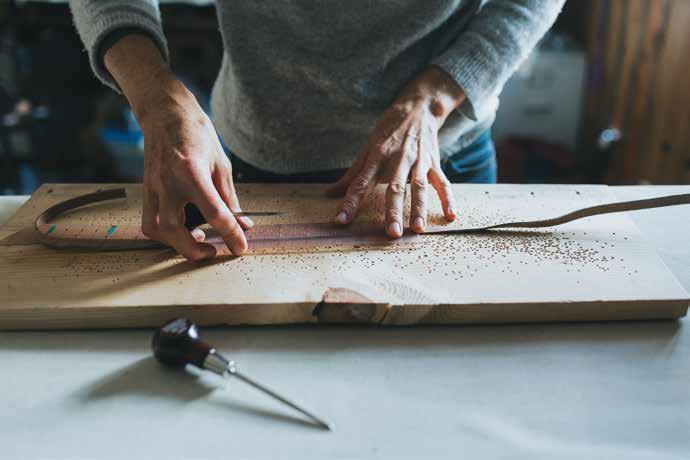

Appearing in runway shows by Gucci, Thom Browne, and Chanel, to name a few, it’s clear that cowboy hats have come into vogue in recent years. Even in Aspen, where Western wear has long been a way of life, the utilitarian accessory has surpassed its function of protecting the wearer from the elements and taken on new life as a statement piece. Now a must-have both on the trail and about town, no trip to Aspen is complete without adding a custom piece to your collection. Ahead, meet three local hatters who are mad about the craft of millinery.
The Modern
Born in New York and raised between Southern France and Palm Beach with a model and designer for a father, Nick Fouquet has style in his blood—and a lifelong connection to Aspen. The hatmaker, whose clients include celebrities like Bob Dylan, Lady Gaga, and LeBron James, made annual family trips to Aspen for vacation growing up, and he even moved there for a year in 2008, ultimately choosing Aspen to open his second store location in 2020.
With an evolving lineup of seasonal ready-to-wear collections lining the wall, Nick Fouquet Aspen is the first outpost of the hatmaker’s buzzy headquarters in Venice Beach, California, where his eponymous studio was born out of a garage on Abbot Kinney in 2013. The brand has been equally embraced in Aspen, a place Fouquet describes as “so fucking cool.” “Aspen really understands the roots of Western fashion and culture intrinsically,” he says.
At his minimalistic boutique on Hyman Avenue, clients can shop one of Fouquet’s coveted hats or design a bespoke creation in store. (Be warned, though, the turnaround time for a custom Nick Fouquet is four months or more.) “I don’t really care for trends, to be honest,” Fouquet says. “They come in cycles. There’s more of a Western influence today, but that’ll go away. Hats are ubiquitous—a part of our American culture—and will stay a staple for men’s and women’s wardrobes forever.”
52
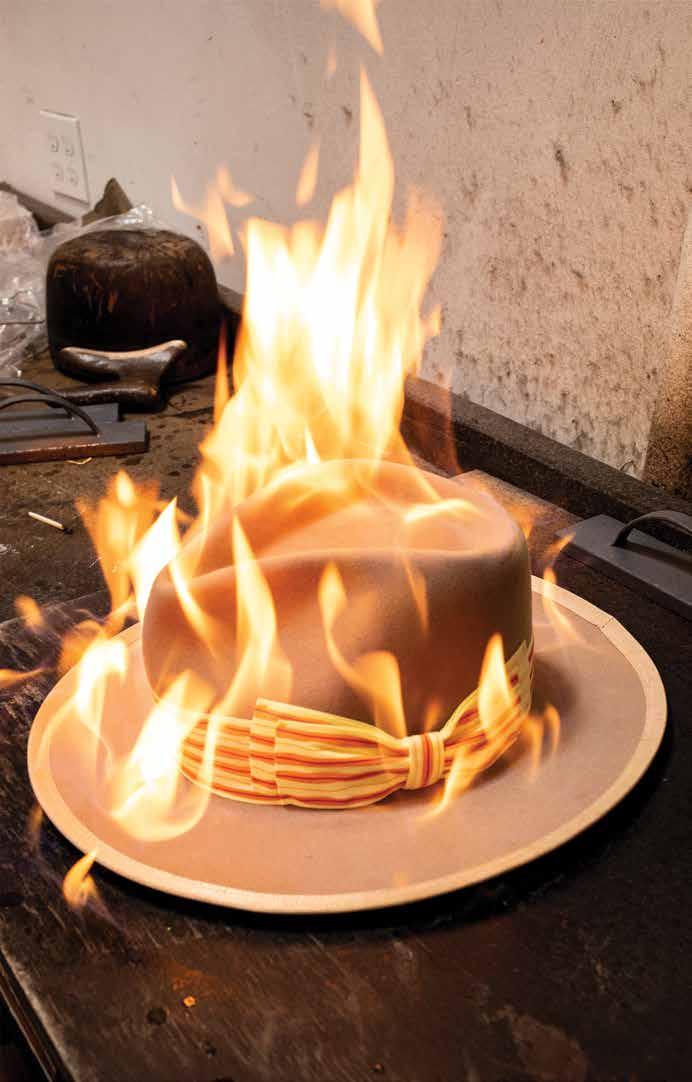


The Western
At Aspen’s longest-running high-end Western wear emporium, shopping for a cowboy hat is an all-out party. And when Wendy Kunkle grabbed the reins from Kemo Sabe founders and longtime Aspen locals Nancy and Tom Yoder three years ago, it marked a new era for the brand, one with an even greater emphasis on heritage, craftsmanship, and style. “Distressing, branding, and swagging hats were all crazy ideas that came directly from our store early on, and top-notch customer service has been the Kemo Sabe mantra for over 35 years,” says Kunkle, who also oversees store locations in Vail, Jackson Hole, Park City, and Las Vegas. “But when I took the company on, I decided to showcase more of who we are as a company and lean hard into fashion.”
With a line out the door on most days during the summer, it’s well worth the wait for entry into this treasure trove of not just classic cowboy hats but also vintage Native American jewelry, belts, buckles, boots, and bags. First, belly up to the saloon-style bar upstairs for a ranch water or margarita, then take your pick of one of the beaver-andrabbit-fur-blended felt hats hanging
on the store’s famed hat wall. A “Wrangler” will guide you through the customization process, which includes visiting the in-store branding station and incorporating a rainbow of ribbons, rare feathers, horse hair bands, bejeweled pins, and more. “Customizing almost everything in our store is something most companies cannot do,” Kunkle says. “We thrive on getting our clients exactly what they dream of to match their personalities.”
Kemo Sabe’s lively customer experience has helped the brand achieve cult status in the decades since it launched in a humble 400-squarefoot space in Snowmass Village in 1990—that, and its high-profile clientele. Appearing on Donald Glover for GQ in 2023, gracing the Ralph Lauren runway in 2022, making many a repeat cameo on Bravo’s The Real Housewives , and accompanying Jeff Bezos on his history-making suborbital flight in 2021 doesn’t hurt, either.
56
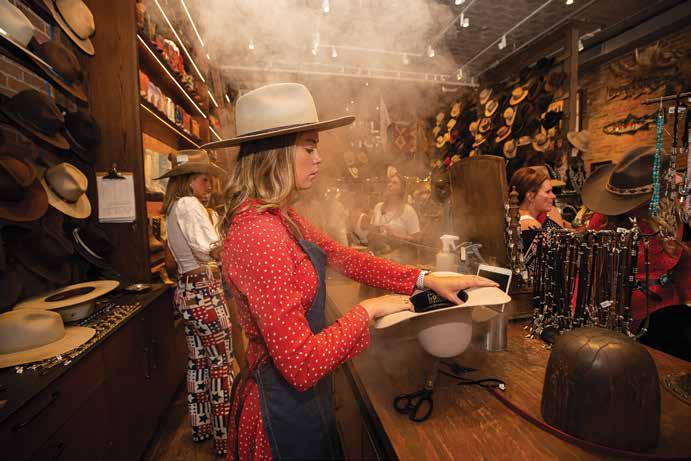
Shopping
a
for
custom hat at Kemo Sabe’s lively retail store on Galena Street is a quintessential Aspen experience.
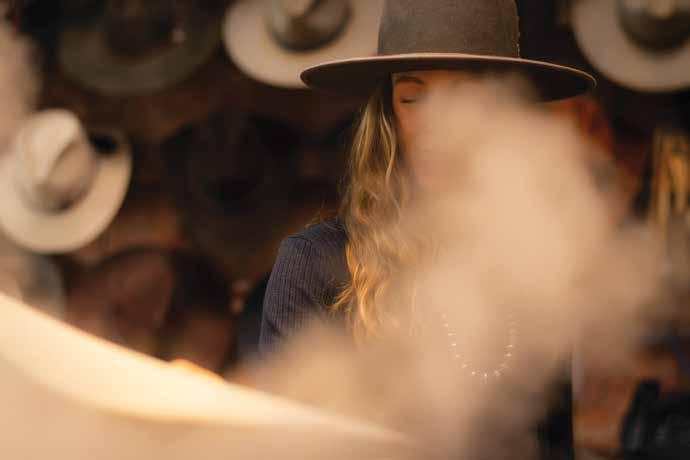 Above, a hat is steamed into shape at Kemo Sabe. On opposite page, Susan Carrolan works out of her hattery in the Aspen Airport Business Center.
Above, a hat is steamed into shape at Kemo Sabe. On opposite page, Susan Carrolan works out of her hattery in the Aspen Airport Business Center.
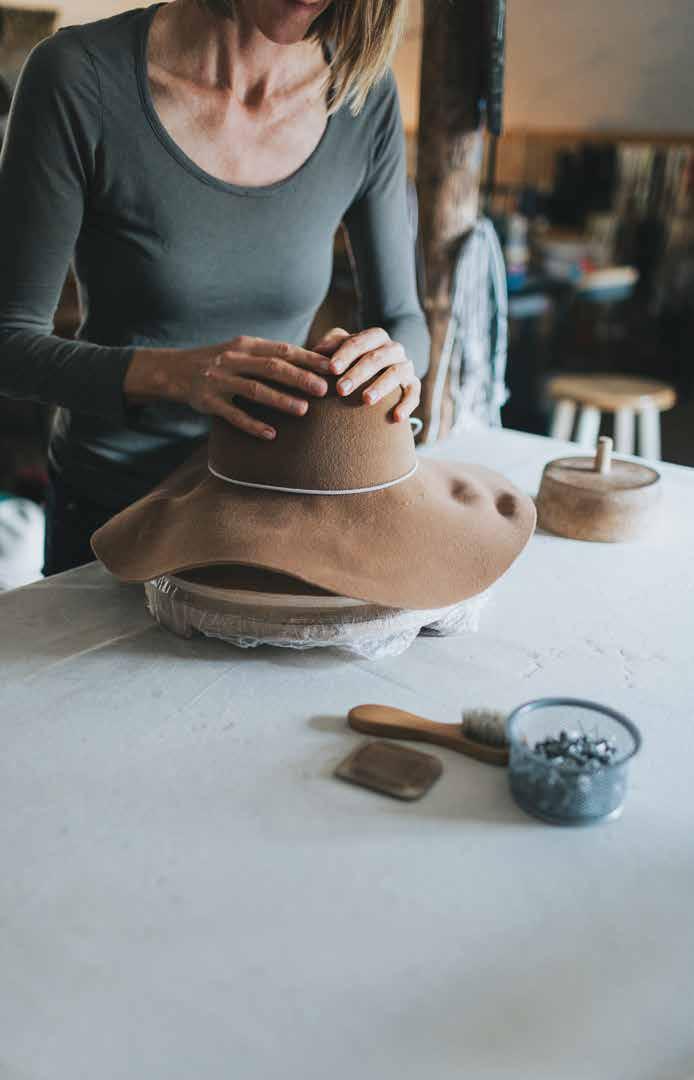
The Classic
Before Susan Carrolan landed in Aspen 23 years ago, she worked in New York as a theatrical milliner making headwear for Broadway shows. “I was ready for a change from city life and wanted to ski,” Carrolan says. “I started selling hats to Hildegard’s—a high-end women’s boutique across from the Wheeler [Opera House] back then. They sold my hats for years, and then I ended up in the Aspen Saturday Market in 2007.”
Today, Susan Carrolan still sets up shop at the market every summer, selling her line of signature straw Panama and felt hats that she finishes with details like Japanese ribbons, beaded bands from the Southern Ute Indian Reservation, and—new for summer 2023—one-of-akind vintage jewelry pieces with a
Western flare, offering extensive sizing options and a generous brim for sun protection.
Her hattery just outside of town in the Aspen Airport Business Center now employs a staff of 10 and is open for drop-ins during store hours or by appointment, when you can shop the latest collection or work with the team on a custom order that’ll be ready in under two weeks. “At the end of each season, I travel to source new materials for the hat-making process,” Carrolan says. “From straws from South America to trims from Europe, that’s my source of inspiration.”
60
Before leaving New York for Aspen more than 20 years ago, Susan Carrolan was a theatrical milliner for Broadway.
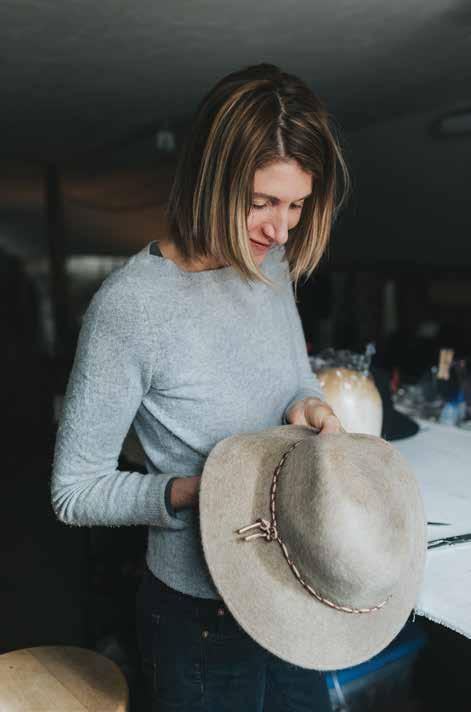

From humble beginnings, Anderson Ranch continues to evolve as a creative haven in the Roaring Fork Valley.
The town of Snowmass Village and the vast ski area in its midst have grown into one of North America’s preeminent year-round resorts since the lifts started spinning in December 1967. Likewise, the village’s Anderson Ranch Arts Center has become among the country’s foremost creative hubs for artists and collectors since its inception in 1966. This synchronicity was both intentional and serendipitous.
As Snowmass developers planned the fledgling resort, they asked celebrated ceramicist and Aspenite Paul Soldner to establish an arts center. He chose a former sheep ranch in the Brush Creek Valley as the venue, with ceramics and photography as its first disciplines. But from those humble beginnings, when artists pulled double duty as arts center stewards— shoveling manure out of farm sheds, hosting potluck suppers, and crashing out in sleeping bags—it would have been a stretch to envision the Anderson Ranch of today.
Now a sophisticated working arts center, the ranch also
embraces sculpture, painting, woodworking, printmaking, digital fabrication, and more under its creative umbrella. Both emerging and internationally renowned creators, as well as the public, come for a yearround slate of workshops, lectures, and exhibits, plus beloved annual events like an art auction and community picnic. More recently, expanded and new programming aims to include more artists and more community members within the ranch’s fold.
What hasn’t changed: the idyllic five-acre setting. Many of the original rustic cabins and barns remain (joined by outbuildings moved from other local ranches), but they’ve been transformed into studios (open 24/7), classrooms, galleries, and dormitories. Newer architecture pays homage to the center’s agricultural roots. Meanwhile, the craggy peaks of the Elk Range soar in the background. “It’s magical,” says Liz Ferrill, a longtime artistic and program director at the ranch, who lives on campus with her husband and their two young children.
State of the Art
62
Text by Cindy Hirschfeld
Images courtesy of Anderson Ranch Arts Center
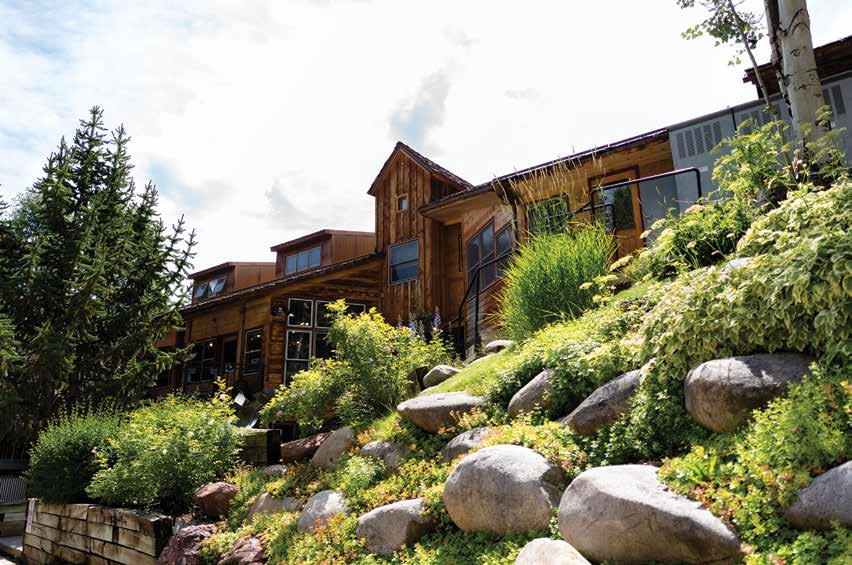
That landscape also inspires those who stay at the ranch as part of its artistsin-residence program. “Being around nature has affected me and my work,” says Andy Van Dinh, a Virginia-based artist who spent five weeks there in March 2023 working on a large-scale drawing and embroidery project. “Even if it was just going for a walk if I was having a hard time in the studio, being in nature reenergized me.”
The residency program has been a signature offering since 1986 but continues to evolve. The ranch offers the space and support, including lodging and meals, for 16 artists at a time to fully immerse themselves in their craft. An interdisciplinary approach means that residents can expand their practices through other mediums, too. “A painter could go to the ceramics studio and try throwing a pot,” says Ferrill, who oversees the program. “It helps them to think about other avenues their work could take.”
More recently, the digital fabrication lab has become a hub for many residents, enabling them to experiment with incorporating emerging technology into their work. “I’ve seen them use it so much,” Ferrill says. “It’s really changed our residency program.”
64
 Miami artist Cornelius Tulloch spent five weeks at Anderson Ranch as an artist in residence in spring 2023.
Miami artist Cornelius Tulloch spent five weeks at Anderson Ranch as an artist in residence in spring 2023.
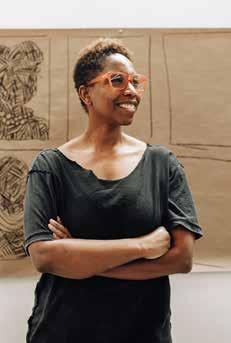


66

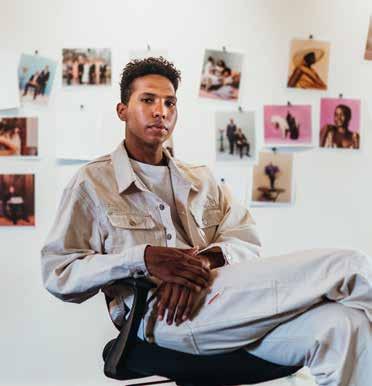
The visiting artists program reflects the ranch’s multidisciplinary ethos, embracing sculpture, painting, woodworking, printmaking, digital fabrication, and more.
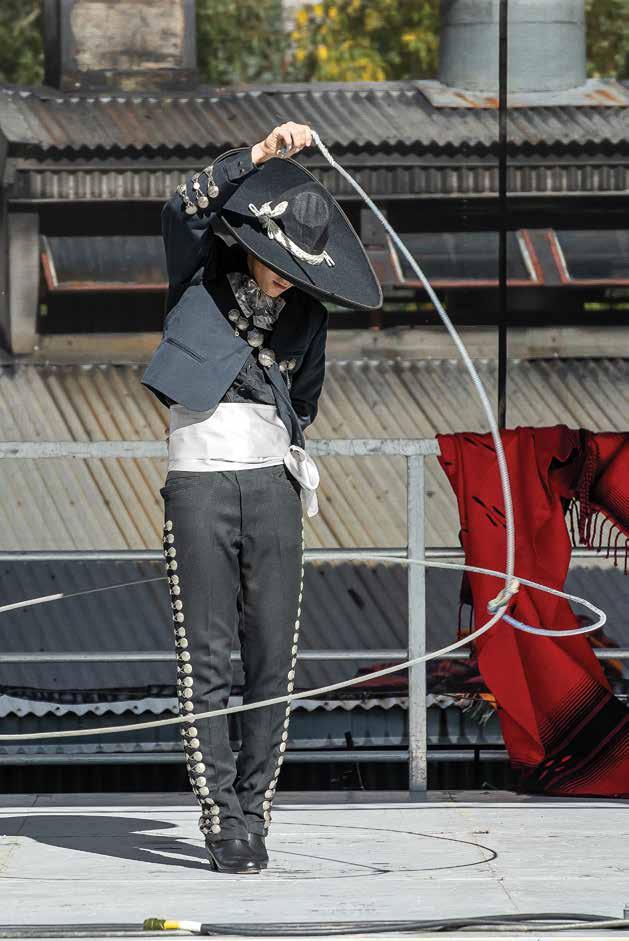
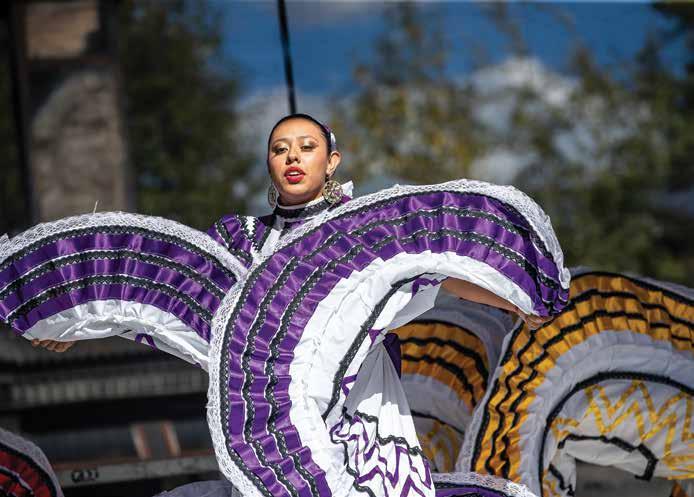
Anderson Ranch Arts Center hosts an annual celebration during National Hispanic Heritage Month as part of a recent initiative to expand Latinx arts programming in the valley.
To accommodate a broader swath of artists, the program was modified a few years ago to offer five-week stays in addition to the traditional 10-week sessions. Soon, the ranch hopes to offer residencies that welcome artists and their families.
Another initiative to bolster inclusivity centers on increased outreach to the region’s Latinx community. Says program coordinator Olivia Martinez, “Our strengths lie in our artists, and we want to share that with other communities who haven’t historically been a part of the ranch. We have a responsibility to ensure that our programming aligns with the values and culture of our community.”
The ranch now hosts two Latino or Latina visiting artists each fall, who get studio time and help lead a workshop for local educators. (Painter and printmaker Ricky Armendariz and digital artist Rafael Fajardo kicked off the new programming in fall 2022.)
70
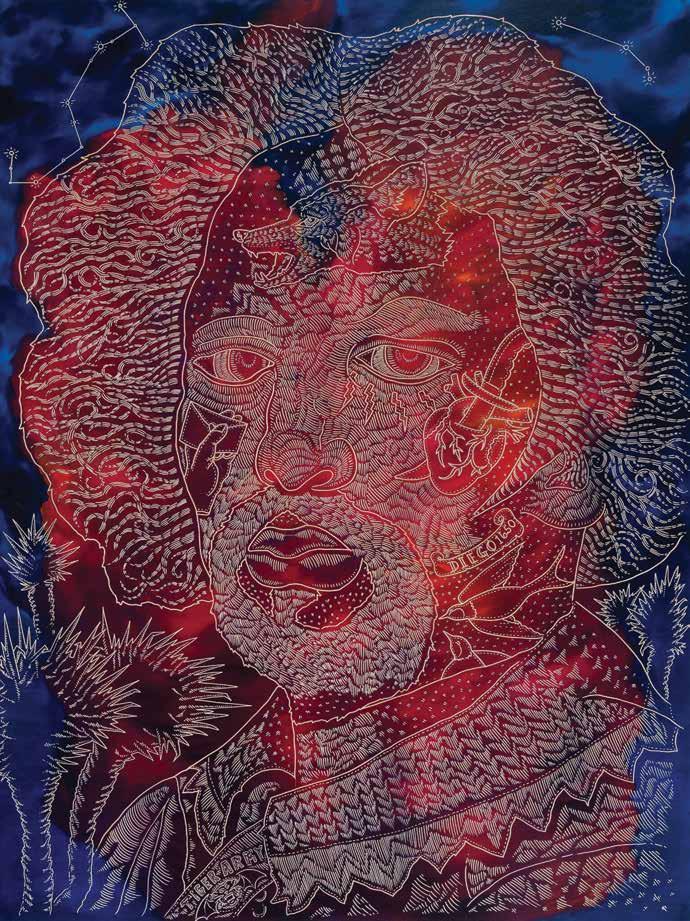 This carved oil painting on birch plywood by Anderson Ranch visiting artist Ricky Armendariz depicts Spanish Baroque painter and former slave Juan de Pareja.
This carved oil painting on birch plywood by Anderson Ranch visiting artist Ricky Armendariz depicts Spanish Baroque painter and former slave Juan de Pareja.
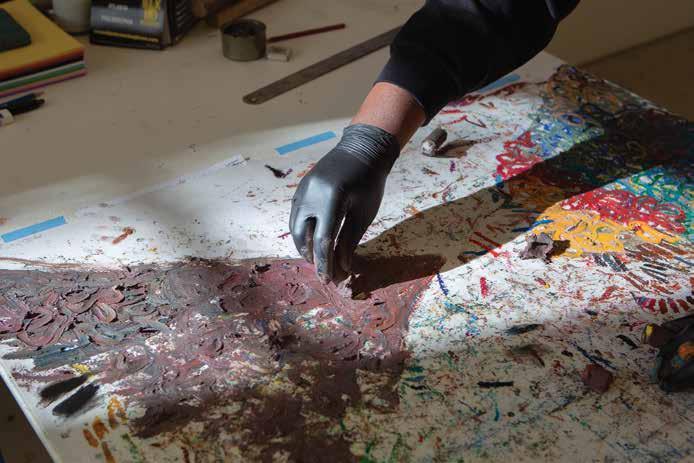 Brooklyn artist Kemar Keanu Wynter is pictured at Anderson Ranch Arts Center during his time as an artist in residence in 2022.
Brooklyn artist Kemar Keanu Wynter is pictured at Anderson Ranch Arts Center during his time as an artist in residence in 2022.
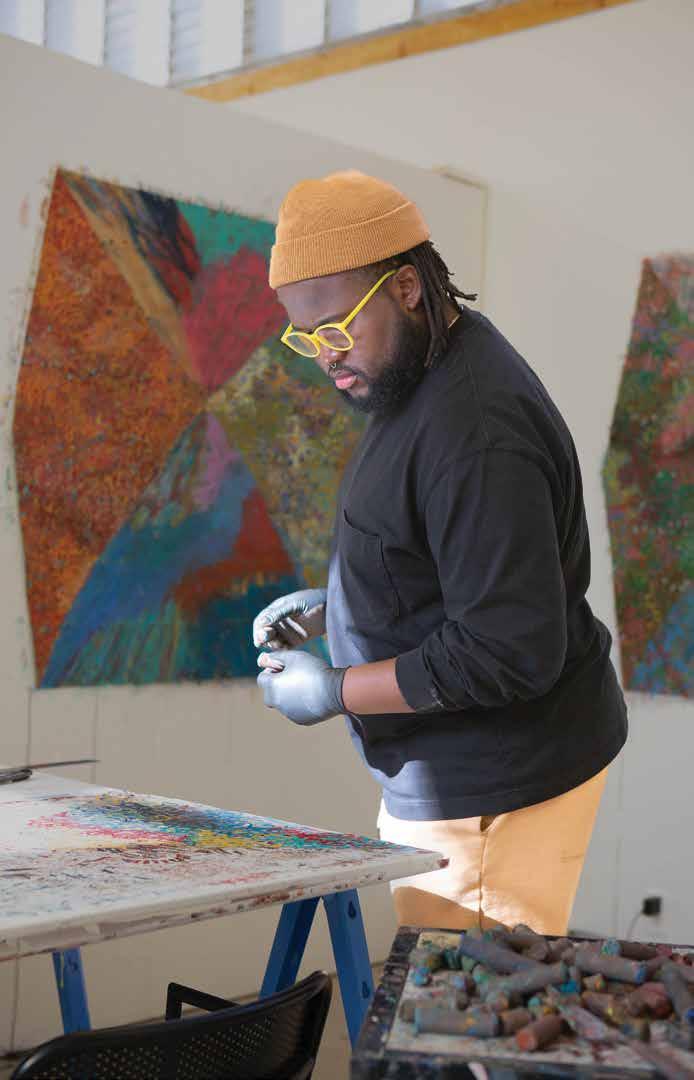
Other components include an online Latinx arts curriculum for teachers to use, school field trips, and student scholarships for summer workshops. Plus, an annual Hispanic heritage celebration takes place at the ranch in September, gathering the community for art-making activities, live music and dancing, a performance by Aspen Santa Fe Ballet’s Folklórico ensemble, and food vendors. The event drew some 600 people in 2022.
In addition to better serving the valley’s Latinx community, another aim of the new programming is to increase awareness of contemporary Latinx artists among art lovers of all backgrounds. “People are so used to hearing about Frida Kahlo and Diego Rivera, and that’s great, but there are living Latinx artists today who are making incredible work,” Martinez says.
The outreach isn’t limited to fall, either. Leticia Guzman Ingram, a teacher at Basalt High School who works with newcomers—kids who have been in the U.S. less than six months—was able to take advantage of a ranch visit in
March 2023 by Maria De Los Angeles, who will return in autumn as a Latinx visiting artist alongside architect Ronald Rael. The assistant director of painting and printmaking at the Yale School of Art, De Los Angeles guided Ingram’s students through a project to design custom sweatshirts over nearly three weeks. “She was a great role model,” Ingram says, noting that De Los Angeles arrived in the U.S. as a young undocumented immigrant. “Hearing her story and how she’s now teaching at a prestigious university in the U.S. was inspiring.”
When Paul Soldner founded Anderson Ranch, he was adamant about forging a sense of community at the arts center. The Latinx programming builds on that vision. Martinez hopes that more locals of diverse backgrounds will feel comfortable visiting the ranch or making art there. “Whether you’re an artist or just having fun, art brings people together,” she says. “It’s a wonderful way to share stories and have amazing conversations. It’s the beginning of a dialogue.”
74


Meet two frequent fliers at Aspen/Pitkin County Airport, a hub for eye-catching aircraft and a vital link between Aspen and the world.
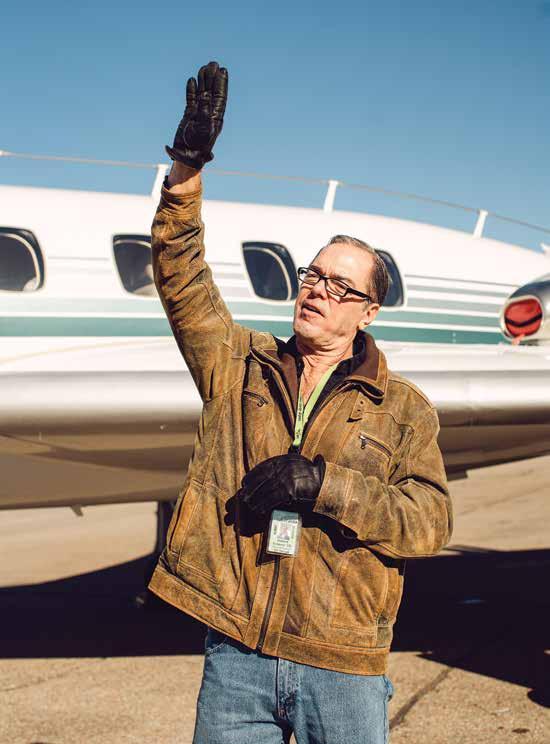 Text by Kelly J. Hayes
Text by Kelly J. Hayes
The Aviators 76
Images by Trevor Triano


ASE: Pilots the world over immediately recognize those three letters as the flight code for Aspen/Pitkin County Airport. Sardy Field, as it is sometimes called, is as well known for its challenging, high-altitude flying conditions as it is for the amazing collection of “heavy metal,” including some of the world’s largest private jets, that crowd its tarmac. “For many pilots, there are bragging rights to saying, ‘I landed in Aspen,’” says airport director Dan Bartholomew. “Pilots have to be on their toes.”
TK.
The airport’s single runway is tucked tightly into a narrow valley requiring an extra-steep descent, with little wiggle room on a missed approach. Changing weather conditions combined with steady traffic—ASE is Colorado’s thirdbusiest airport—means that pilots must be precise.
And then there is the notable bling. Bombardier Global and Gulfstream G series jets (whose price tags exceed $60 million) are often lined up wingtip-towingtip during ski season and arrive in droves for Aspen’s most significant summer events, when celebrities and the intellectual and corporate elite vie for space in this tony hamlet. “It can be pretty eye opening,” Bartholomew says, referring to the private jet traffic that accounts for 80 percent of all take-offs and landings at the airport.
But for Aspen residents, the airport is about more than just heavy metal. It is a vital link to the rest of the world via daily commercial service by United, Delta, and American Airlines. And it is a place where those with a passion for flight can indulge under pristine mountain skies. Since the field first opened in 1946 with a gravel runway and log-cabin terminal, it has consistently drawn a cadre of local aviators.
78
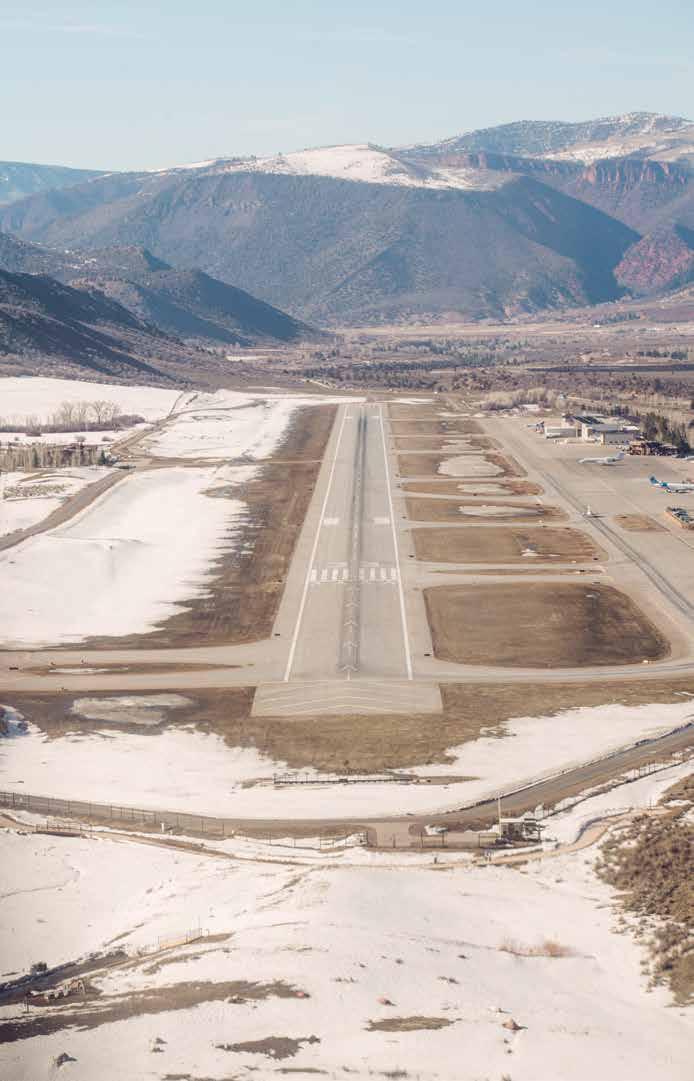


The Instructor
“Flight check complete,” says Hannah Simpson, steering one of the Aspen Flight Academy’s (AFA) compositebody, single-engine Diamond DA40 NG aircraft to the runway. As she readies for takeoff on a scenic spring flight through Independence Pass to the Leadville Airport, the highest on the continent at 9,934 feet, she says, almost to herself, “I’m so fortunate to be able to fly here.”
The 23-year-old graduate of Purdue University’s highly acclaimed professional flight program brings a confident and ebullient personality to her position as the AFA’s lead certified flight instructor. The daughter of a commercial aviator, Simpson embraces both the joys and challenges of flying out of ASE. “Aspen is a monolith,” she says. “You see things here that you don’t see anywhere else. And there is a very tight aviation community with committed pilots.”
To help foster that community, the nonprofit AFA was founded in 2014
by a group of passionate local flying enthusiasts to provide tools and instruction to those interested in learning to pilot aircraft. Today, the AFA hosts one of the most innovative introductory flight training programs in the country: Every Student Flies, an initiative in partnership with the Aspen School District to introduce local students to aviation. Every student at Aspen High School has an opportunity to take a free flight and then enroll in elective credit classes that prepare them to obtain private pilot certificates, instrument ratings, and commercial ratings.
“I don’t know of any other place that has a program like this, and the students love it. Just this morning I had a 16-year-old student who made his first solo flight—he was thrilled,” says Simpson, who also sees the program as an unparalleled avenue for offering young women opportunities within the male-dominated aviation industry.
“To be able to help young people engage with my passion for flight is an only-inAspen experience.”
82
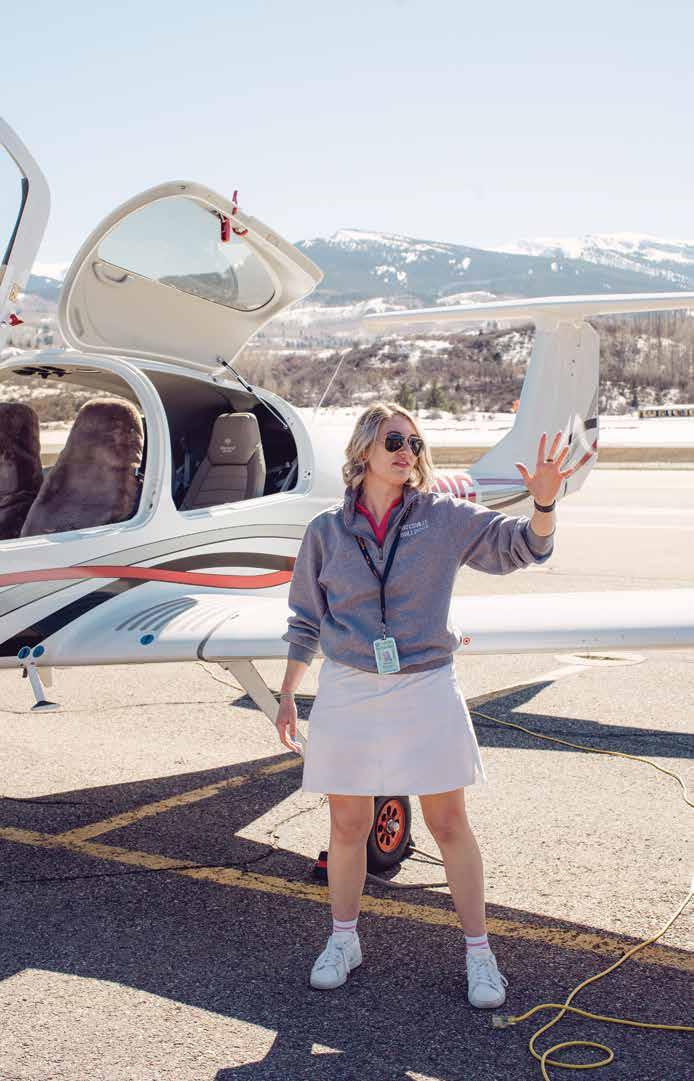
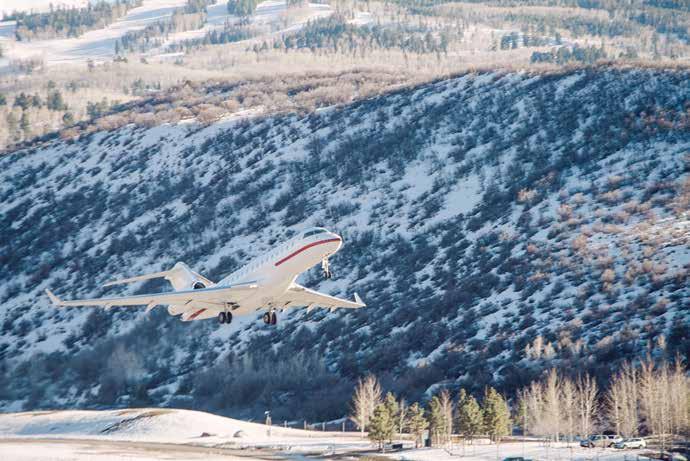
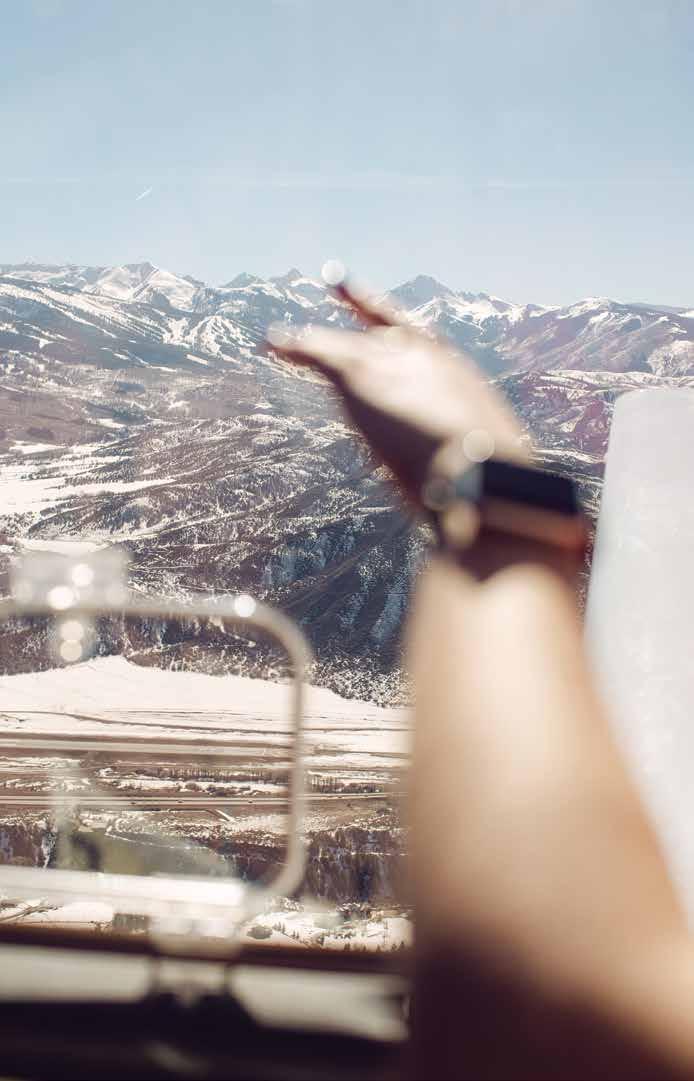
The Pilot
“When I taxi down the Sardy Field runway in front of the private jets, I can see the pilots in the cockpits with their phones out taking pictures of the Starship,” laughs longtime Aspen aviator Robert Scherer, the proud owner of one of the most unique and rare planes in aviation history.
With its rear-facing twin propellers that push the plane forward in a “pusher” configuration, along with its canard design featuring a secondary stabilizing wing near the nose, the Beechcraft Starship captures the attention of not just airplane junkies, but just about anyone who sees it.
“I was looking to buy a King Air because I needed a plane that I could fly in and out of Aspen,” Scherer says. “But one day, I saw an ad for a Starship, and I knew I had to have it.” Today, of the 53 Starships that were originally produced in the
1980s and ’90s, Scherer’s NC-51 is one of just four with its original Commuter Category certification. As the first corporate aircraft to feature 100 percent advanced composite construction and a digitally integrated flight management system, “it was supposed to be the future of airplane design,” Scherer says, running a hand over the plane’s wing with obvious affection.
For Scherer, becoming the owner of such a unique aircraft was lifechanging. “Everyone in the flight world wants to fly it or be around it. I’ve had an opportunity to fly as a chase plane for [pioneering aerospace engineer] Burt Rutan’s SpaceShipOne, which won the X Prize for suborbital spaceflight. I’ve flown [business magnate] Sir Richard Branson and had astronauts who have been to the moon on board,” he says, pausing. “Sometimes I feel like Forrest Gump.”
86

Bayer
Was Here
A look into the work of Bauhaus artist Herbert Bayer reveals his enduring influence on Aspen’s spirit and built environment.

88
Text by Andrew Travers
Images by Jakob Helbig, Timothy Mulholland, Tony Prikyrl, Trevor Triano, and courtesy of the Aspen Institute, Aspen Historical Society, and David Rumsey Map Collection
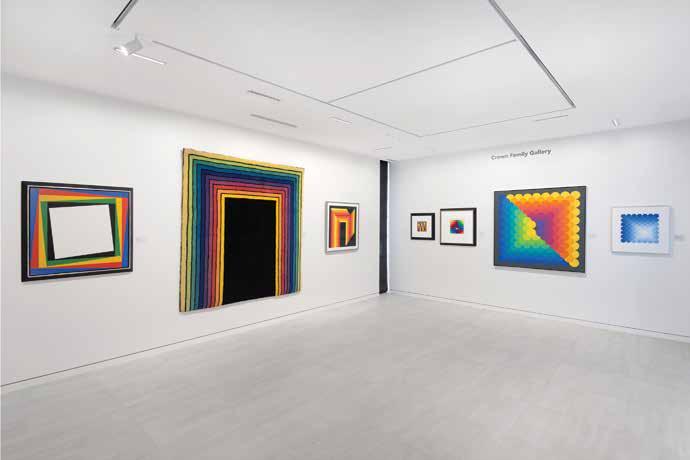
Artist, designer, and polymath Herbert Bayer molded the physical and cultural landscape of Aspen over the course of its three most formative decades. As a young artist in the 1920s, Bayer studied and then taught at the influential Bauhaus school in Germany before embarking on a successful graphic design practice. He fled Nazi Germany for the U.S. in 1938 and immediately organized a Bauhaus exhibition for the Museum of Modern Art in New York, where he first came to the attention of industrialist-philanthropists Walter and Elizabeth Paepcke.
Arriving in Aspen in 1946 to work with the Paepckes to shape the utopia they envisioned there—one grounded in the “Aspen Idea” of elevating mind, body, and spirit—Bayer applied his multidisciplinary genius to imbue the depopulated silvermining town with the Bauhaus school’s creative ideal of a “total work of art.” “What the future of Aspen promised then was the participation in shaping an environment,” he wrote in 1967. “This was one of my motives in choosing Aspen as a place to live and work.”
Today, Bayer’s influence can be felt on the idyllic campus pathways and in the inspiring gathering spaces he conceived for the Aspen Institute, and in the Bauhaus-inspired architecture that still peppers Aspen. And when the Resnick Center for Herbert Bayer Studies opened its doors in 2022, a new generation of Aspenites and visitors were introduced to his wide-ranging creative genius.
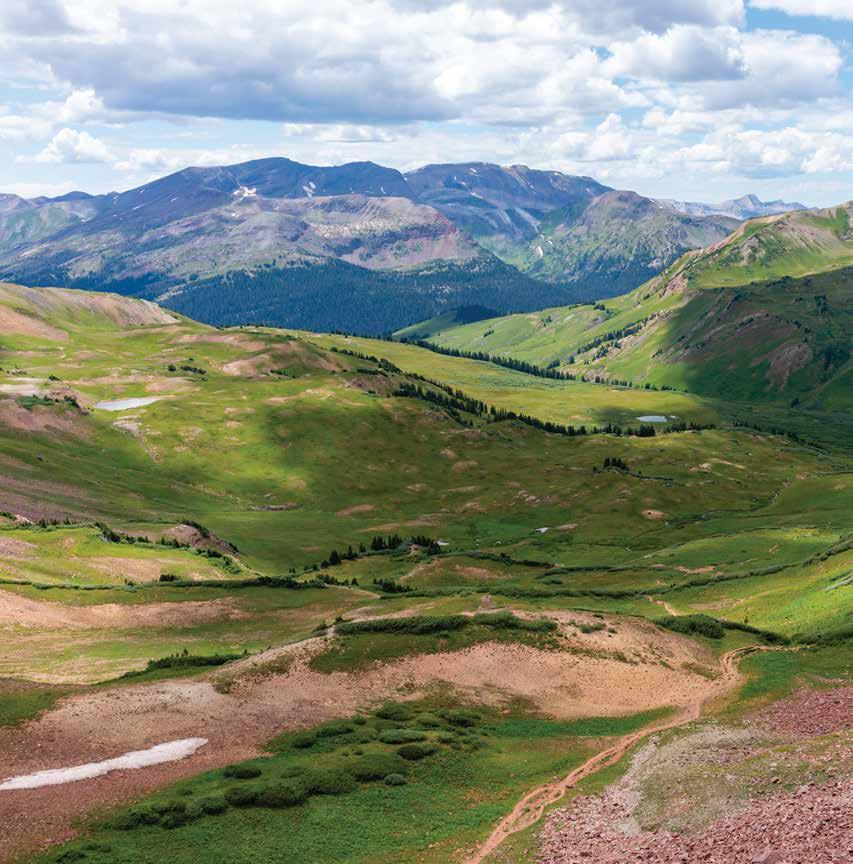
Born in the Alps, in Haag am Hausruck, Austria, in 1900, Bayer was a lifelong skier and mountaineer whose passion for the alpine lifestyle naturally made its way into his work. During a winter stay in Stowe, Vermont, in 1944, Bayer began his Mountains and Convolutions series, which exploded with inspiration upon his move to Aspen—combining Bayer’s study of geology, cartography, and geometry as he began viewing mountainscapes as living, moving organisms that evolved through the ages.
“I saw the mountains not in their textured and detailed shapes, but suddenly saw them as expressions of interior forces, as undulating forms whose motion is caused by forces of time and geology,” Bayer explained in a 1973 interview. “Of course, we do not see this motion, but if we could make a time-lapse painting of mountains stretched over millions of years, we would see this motion.” The series included paintings, tapestries, and other mediums but culminated in Bayer’s etched sgraffito mural on the side of the Koch Seminar Building, completed in 1953 as his first structure on the Aspen Institute campus.
91
“The artist needs business, and business needs useful art,” Bayer said at the inaugural Aspen Design Conference in 1950. To that end, Bayer used art to market Aspen as a destination. He designed Aspen Ski Corp.’s original aspen-leaf logo, pins, and event programs to promote tourism and crafted the first posters championing the town’s ski hills, including the now-iconic “Ski in Aspen” designs that collaged alluring photos and illustrations of skiers and fixated on the interconnecting “S” and “8” lines carved in the snow as they link turns.
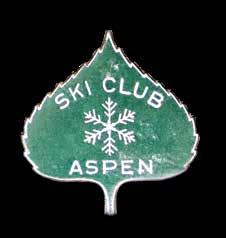

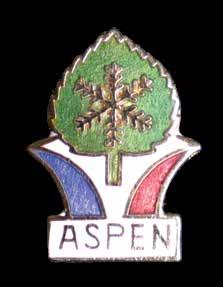
92
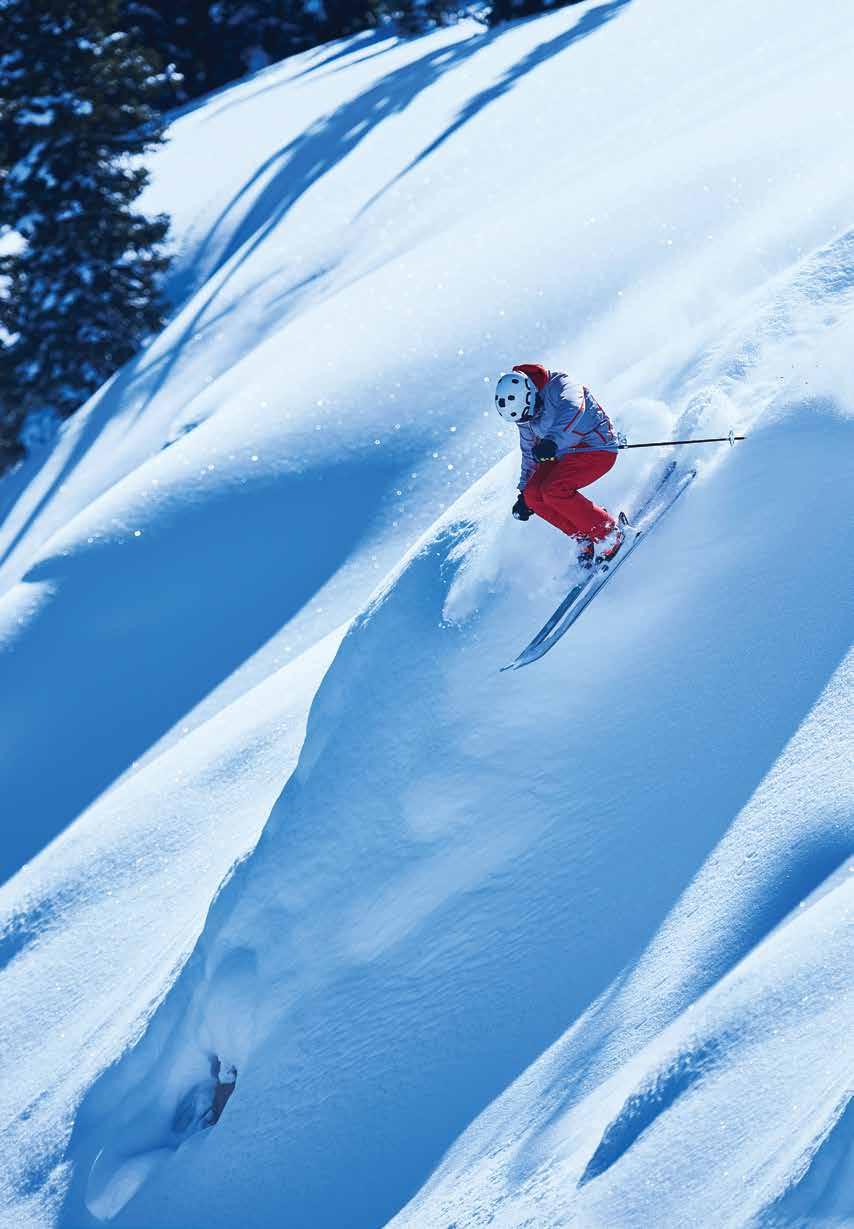
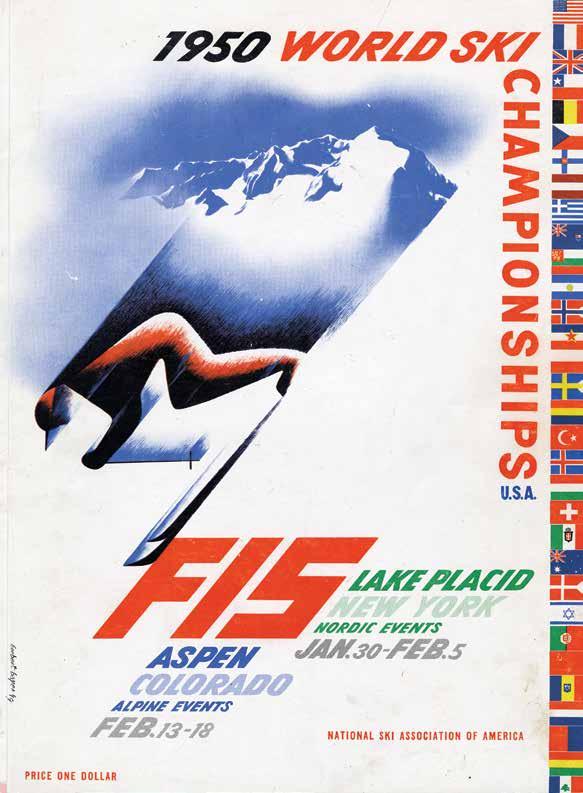
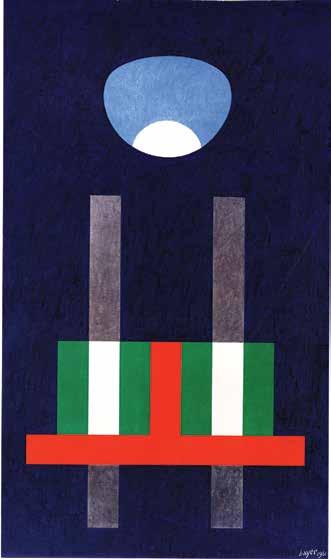
While championing historic preservation and serving as a planning commissioner in Aspen, Bayer also placed his stamp on the traditional white picket fence.
The “Bayer fence,” with its crenelated tops in the style of castle battlements, was once commonplace in Aspen’s West End, enclosing the yards of restored Victorians like Bayer’s home on West Francis Street, where a restored Bayer fence still stands.

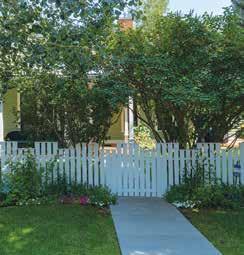
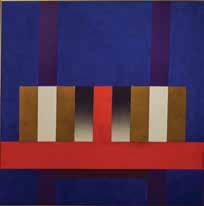
Bayer’s devotion to functionality and his sense of whimsy are embodied in his Kaleidoscreen , a seven-foot-tall, 12-foot-wide aluminum sculpture with seven multi-colored adjustable panels that fit together like a jigsaw puzzle and are meant to open and close with a hand crank. Completed in 1957, this louvered aluminum screen originally provided shade for sunbathers at an Aspen Meadows Resort swimming pool. Today it sits beside the Walter Isaacson Reception Center at a trailhead leading to the Roaring Fork River. The Bayer Center is soon to embark on a $73,000 critical restoration of Kaleidoscreen
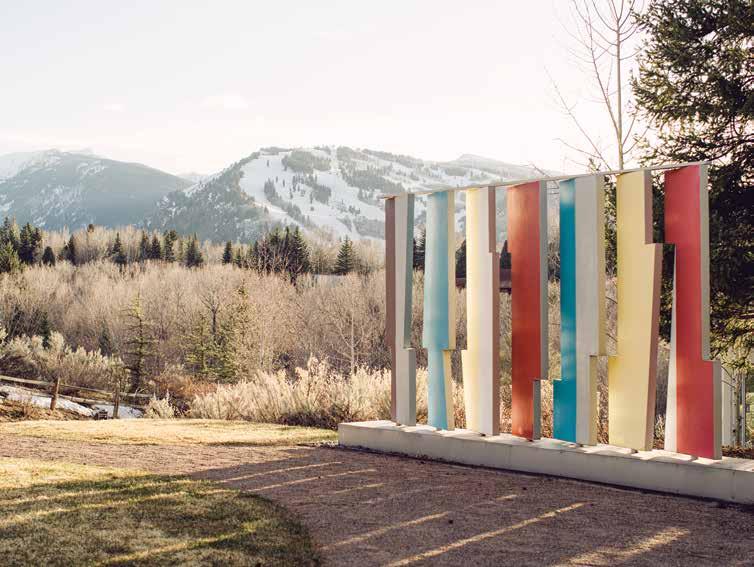
95
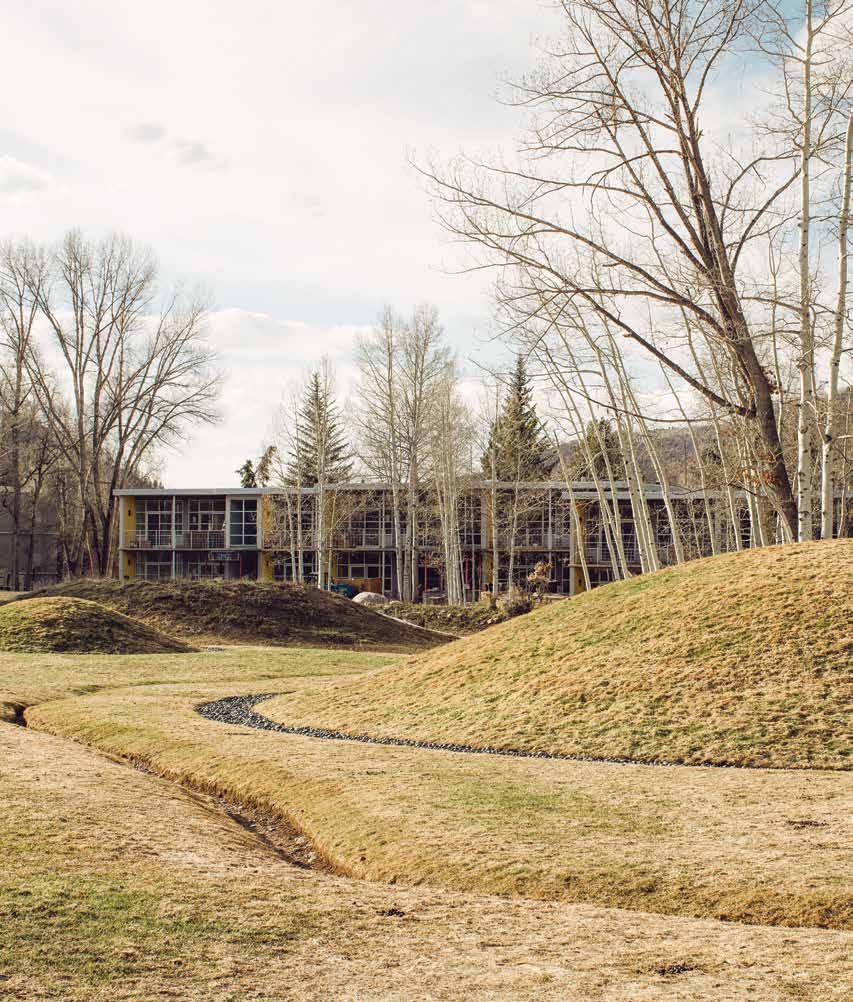
96

Bayer’s masterpiece is the Aspen Institute campus itself. Across more than two decades, Bayer designed its buildings, landscape, sculptures, and earthworks. Here Bayer visually explored the earth, light, shadow, and humanity’s place in the world with physical manifestations of ideas he had first investigated on canvas. Bayer described his approach to permanent works like Grass Mound (1954), Marble Garden (1955), and Anderson Park (1973) as “an inquiry into the reality of space rather than painting the illusion of space on a two-dimensional plane.”
The Resnick Center for Herbert Bayer Studies, opened in 2022 on the southern Gillespie Avenue border of the Aspen Institute’s 40-acre campus, gives the artist’s work a permanent home, with more than 7,000 square feet of gallery space to host rotating exhibitions. Designed by Jeffrey Berkus Architects and Rowland+Broughton, it draws inspiration from Bayer’s architectural work and rigorous attention to geometries, paying homage to Bayer’s visual explorations of the Fibonacci mathematical sequence in its curving entrance pathway. The free museum welcomes visitors with Bayer’s 16-foottall Four Chromatic Gates , a set of four nested steel rectangles painted primary yellow, red, white, and his signature “Bayer blue.”

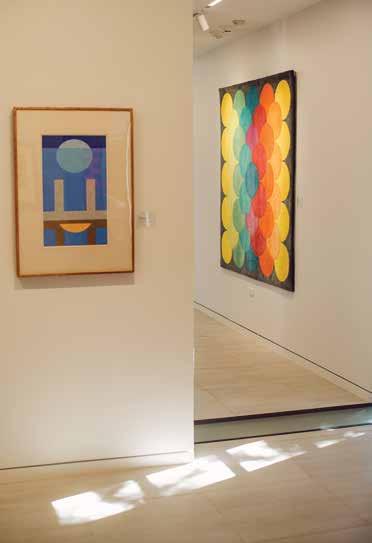
98
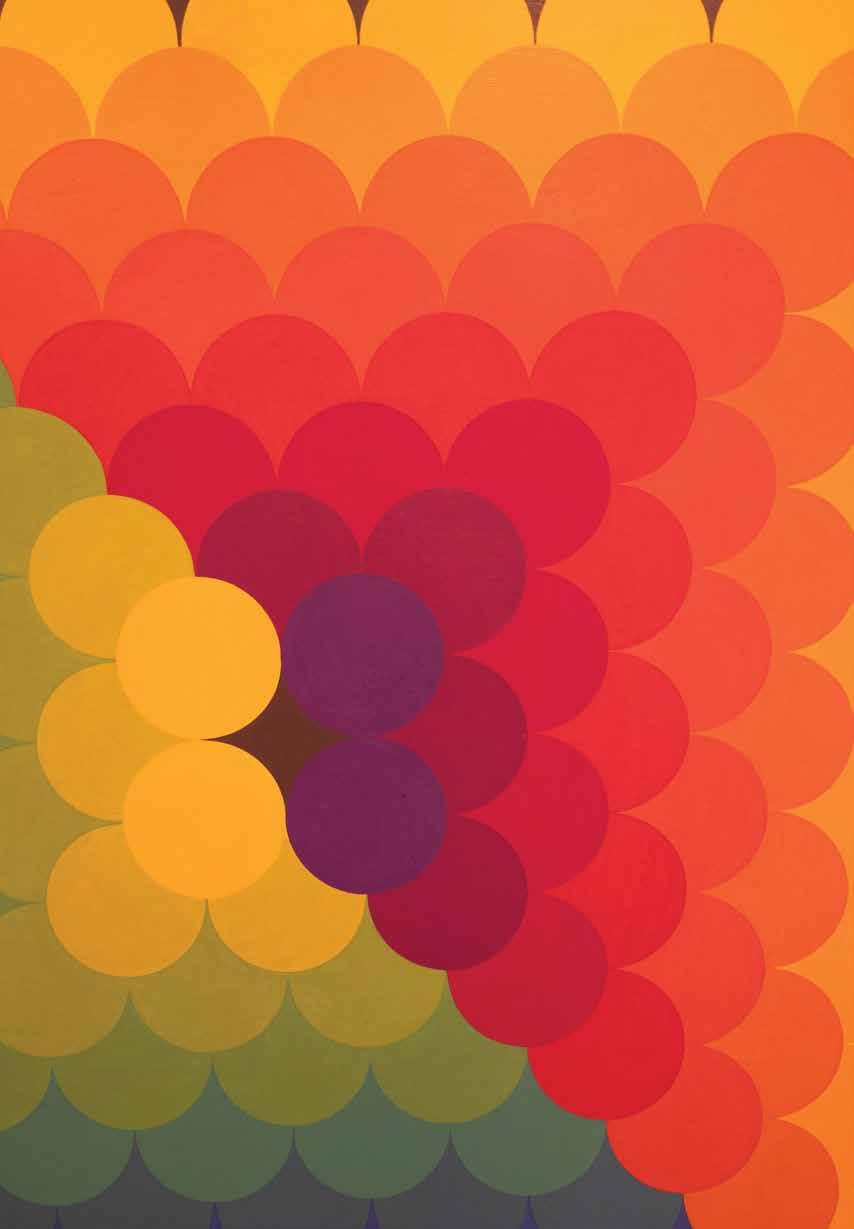
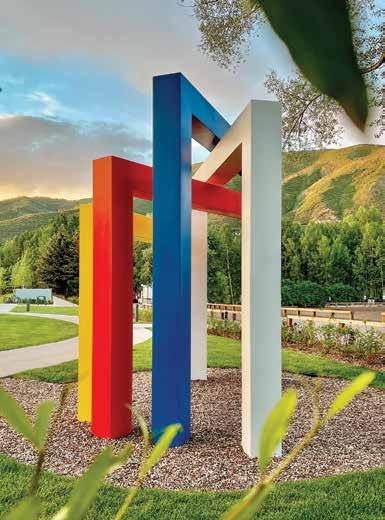
Bayer’s 1953 World Geo-Graphic Atlas changed the course of popular scientific illustrations and data visualization. The book, the subject of multiple exhibitions at the Aspen Institute and its Resnick Center for Herbert Bayer Studies in 2023, unified Bayer’s multidisciplinary practice as artist, designer, and communicator. As historian Benjamin Benus puts it in his new book, Herbert Bayer’s World Geo-Graphic Atlas and Information Design at Midcentury, the atlas “represented a continuation—even a culmination—of projects with which he had been engaged from the earliest stages of his career” when he was a student at the Bauhaus in prewar Germany.
Bayer’s hyphenated title was quite intentional, emphasizing his graphic visual presentation of geography, geology, demography, astronomy, climate, and economics in an artful rebuke of the text-heavy, “letter-poisoned” approach of conventional atlases and encyclopedias. The product of five years of research, collaboration, and creation, the atlas includes stunningly original Bayer artwork and more than 4,000 illustrations.
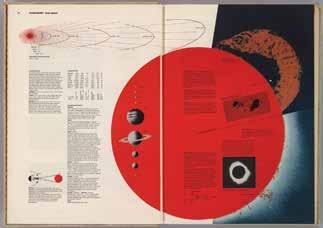
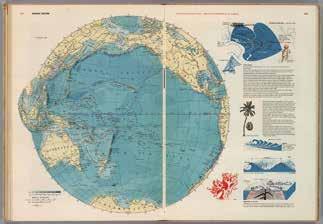
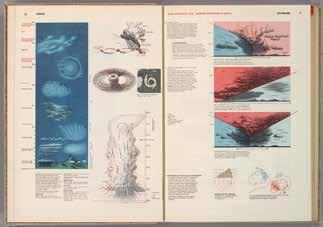
100
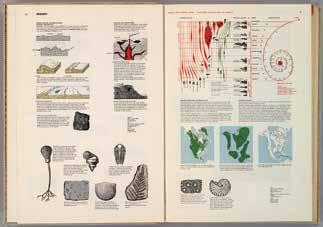
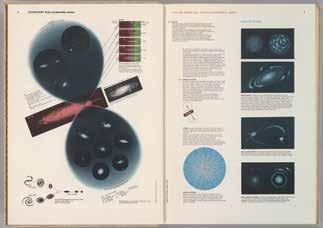

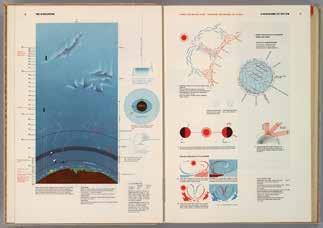
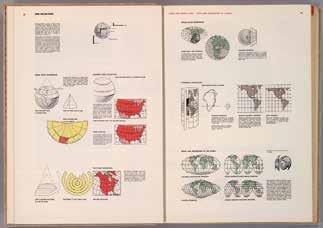
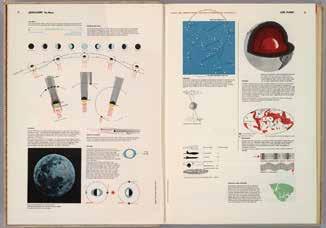 Writer Andrew Travers is the Penner Manager of Educational Programs at the Aspen Institute’s Resnick Center for Herbert Bayer Studies.
Writer Andrew Travers is the Penner Manager of Educational Programs at the Aspen Institute’s Resnick Center for Herbert Bayer Studies.
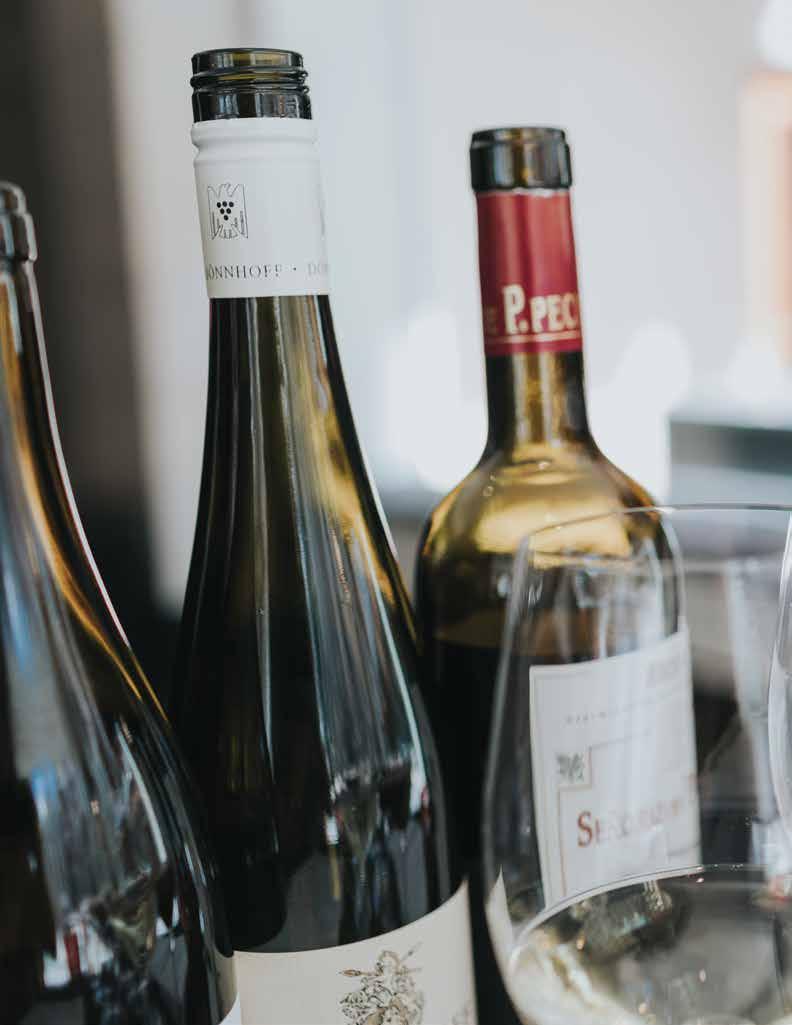 A taste of terroir.
A taste of terroir.
102
Image by Olive & West Photography
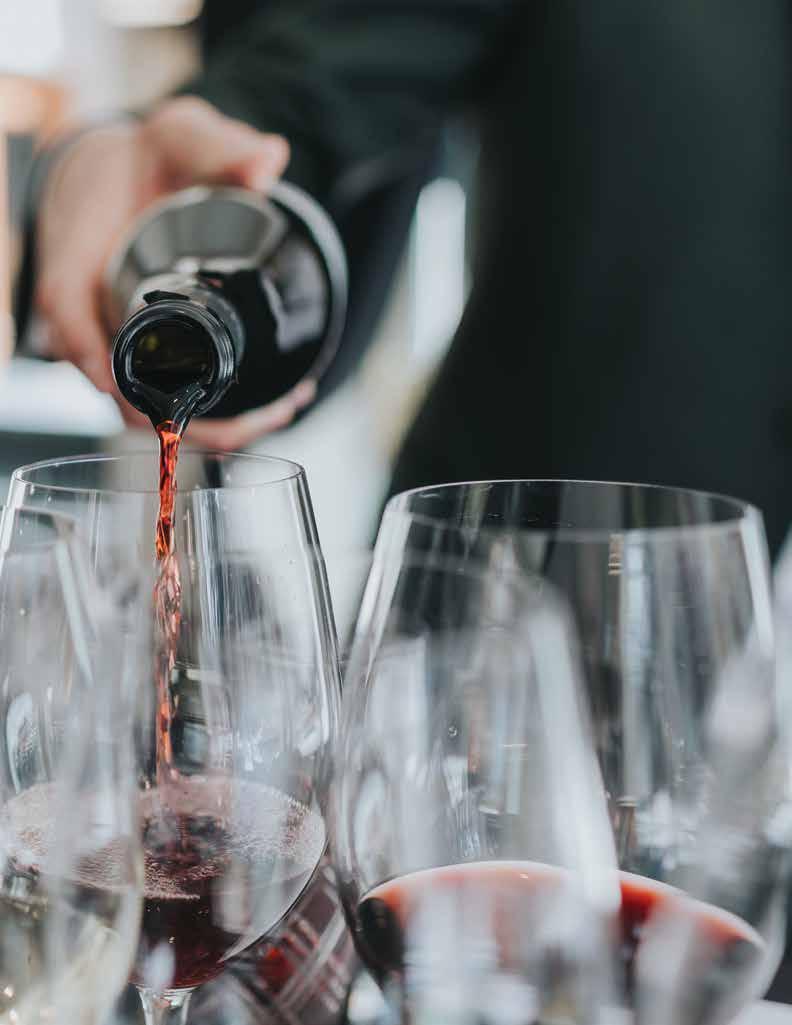
Connect
The youngest member of the Court of Master Sommeliers describes the wine community she found upon moving to Aspen and her jaunts through Italian wine regions in the off-season.
It was Italy that made me fall in love with wine. I went on my first trip to Italy when I was 9 years old and felt an immediate connection, even then. The first course I signed up for in college was Italian. Cornell has an incredible hospitality program, so I transferred into the School of Hotel Administration, majoring in beverage management, while continuing Italian. When I studied abroad in Bologna my junior year, it all clicked. I realized that wine was the way for me to learn about Italian culture, cuisine, and people. Wine was the way I got to know Italy. Piedmont was the first place that truly drew me into its wine culture. I loved
Master Sommelier Maddy Jimerson spends part of each year in Italy, where her love of wine was born.
Images by Olive & West Photography For the Love of Wine with Maddy Jimerson 104
As told to Carey Jones
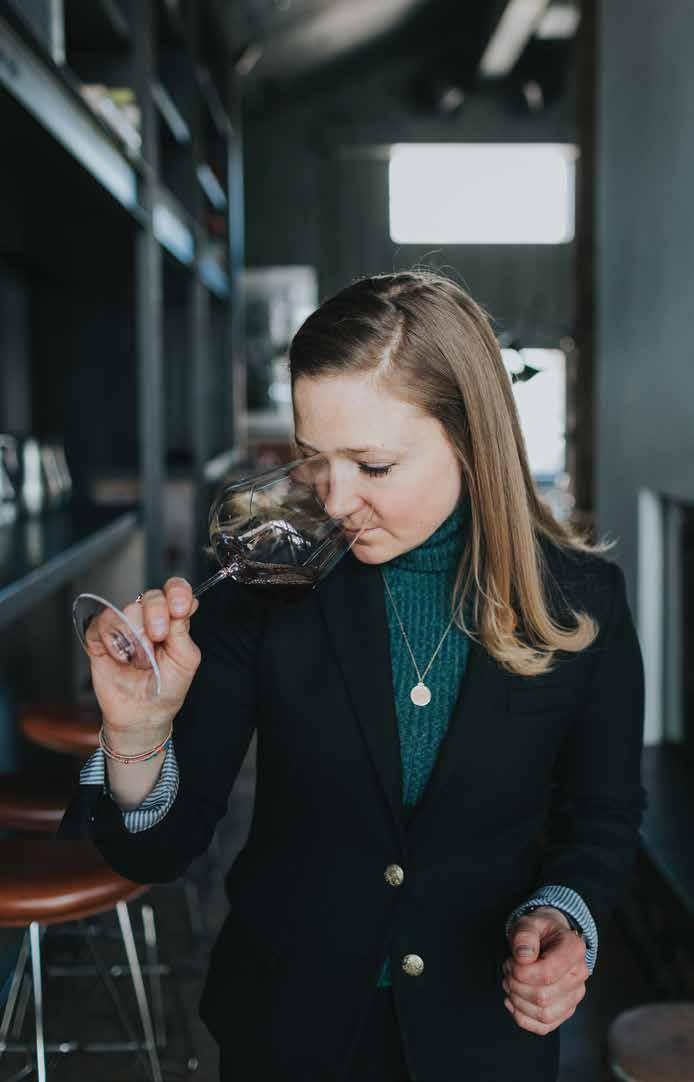
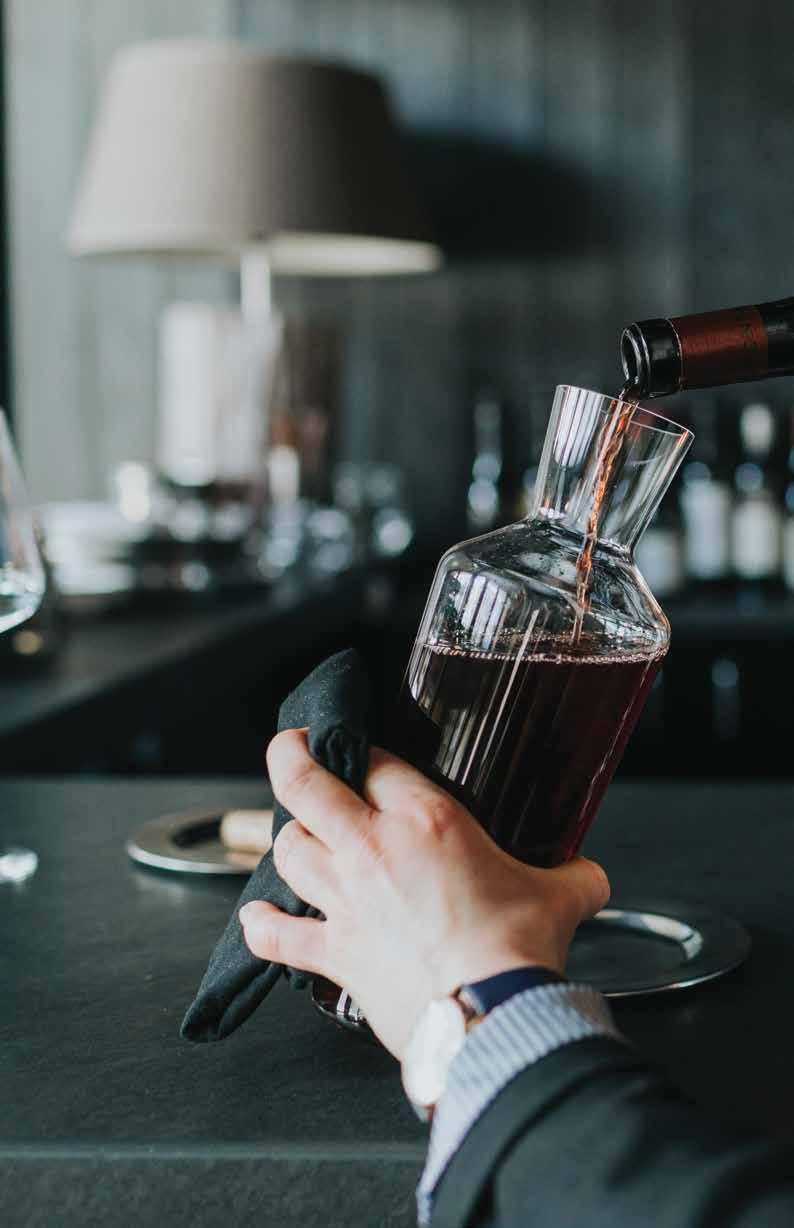

wines from Barolo and Barbaresco; in 2014, I called up every winery I could find a number for, and no one wanted me as a harvest intern. But I flew out anyway, and it turned out my Airbnb was also a winery! I got to know the family, and I begged them to let me work harvest—and they did, eventually. That’s where I first really understood winemaking and viticulture.
After graduation I worked for an Italian wine importer in San Francisco, which was a great start to my career. But one work trip I went on really changed my path: Mount Etna, in Sicily. It was my first time there, and I fell head over heels in love. It’s all volcanic terroir, and it has this energy to it—you taste it in the food, in the wine—everything is on steroids. I called my boss within 24 hours of arriving and gave my two weeks’ notice. I put all my stuff in a storage unit in Reno and moved there. While I worked the harvest, I lived in the back of a pizzeria-
wine bar that was the local watering hole. I’d hang out at the wine bar every night and meet all the producers coming in. It was an incredible experience to get to know the community that way.
I knew Aspen had an incredible wine community, and I’ve always been obsessed with the mountains, so when I came back to the states, I thought, What if I moved to Aspen to work at The Little Nell?
The Nell is what makes our wine community so strong. It attracts so much talent, and that talent is retained in our community. There is so much support for learning about wine. The sommelier team leads wine classes and blind tastings, and the wines they’d open at Element 47 were unreal. Being able to taste just a sip of, say, 1990 Le Pergole Torte—wines you couldn't get access to otherwise—that’s how I really started tasting.
108
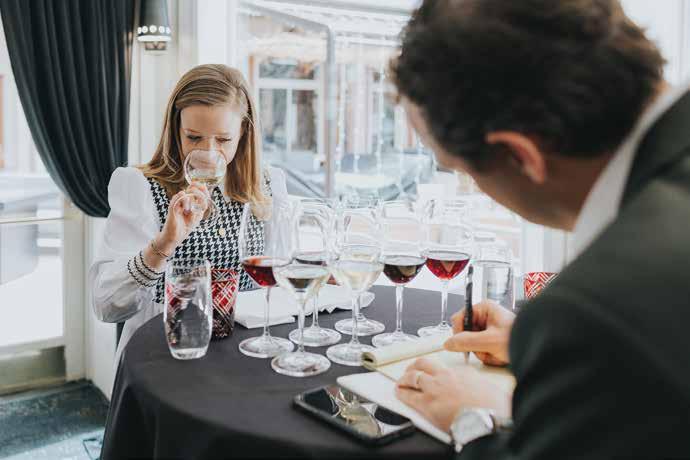 Jimerson takes part in a blind tasting with friend and fellow sommelier Chris Dunaway, wine director at The Little Nell.
Jimerson takes part in a blind tasting with friend and fellow sommelier Chris Dunaway, wine director at The Little Nell.
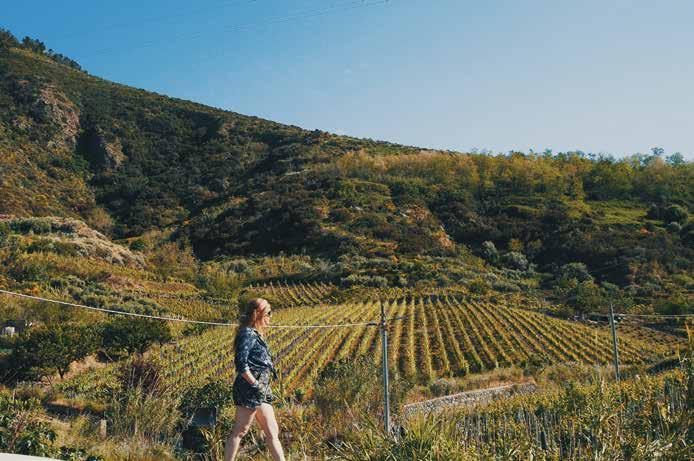

So many people who helped me on my path to becoming a master sommelier came through The Nell. Upon moving to Aspen, I sought out [local wine legend] Jay Fletcher, who became a mentor and good friend. Greg Van Wagner was also instrumental, as was Chris Dunaway, wine director at The Little Nell. Chris and I have become close over the years as we’ve gone through the exams together. (Passing theory with him was one of the highlights of my career.) While I am happy to have earned my “red pin,” my favorite moments have been the times I’ve spent with this incredible group of people.
I took over the wine program at Casa Tua last winter. We’ve been doing weekly tastings for members; we did an old and rare Barolo dinner where we opened up bottles from the 1950s, 1960s, 1970s. Building out our wine list has been so exciting.
But I feel lucky that Aspen has an off-season. I spend that time in Italy. As soon as the restaurant closes, I usually head to Piedmont, and then Sicily as well.
Italy has an older population, and as people die, some traditions die with them. I wanted to help preserve Italy’s old-school winemaking traditions by sharing it with people back in the states, so in 2017, I started a company called Winomad Productions. We create short films about some of Italy’s lesserknown wine regions.
I also lead small wine tours in Aspen’s off-season. I’m taking three people to Sicily in the spring, and I have Piedmont planned in the fall. I love the intimate group size because you can really have a local’s experience. We offer insider knowledge on the best places to eat, based off real relationships with producers—experiences you can’t have any other way.
In Italy, they’re making wine in every single town, in every single part of the country. There’s so much to be explored, sometimes I feel like a wine pioneer. Being able to share those experiences— through the tours, through films, through the bottles of wine we serve at the restaurant—is what I hope to be able to do. It’s so incredible, I can’t just keep it to myself.
112
Jimerson indulges her love of Italy by leading wine tours and producing short films in the country’s lesser-known wine regions.
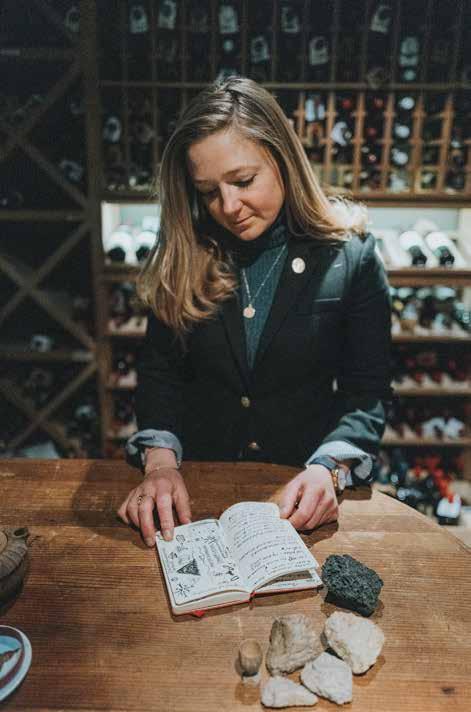

Away with Christian Vande Velde
The retired pro cyclist has competed in some of the most beautiful places in the world but still believes there’s no place like Aspen in August.

As told to Tess Weaver
Steve Goff and Steve West
Images by
Breaking
114
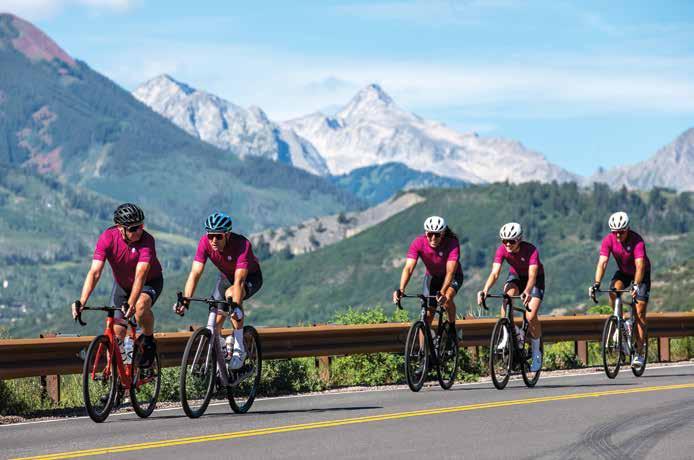
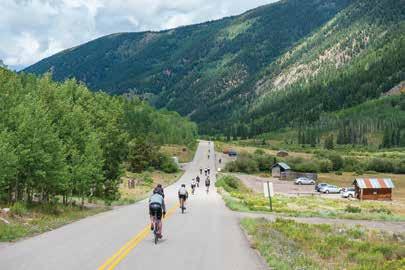
This year is our 10th annual Clip-In Cycling Camp at The Little Nell. I’m honored it’s still going on—it speaks volumes about the value of what we do. We try to mix it up every year—this year we’re doing lunch on top of Aspen Mountain and maybe a point-to-point ride—but we’ve had a winning formula since the first camp, so we try not to mess with it too much.
It’s the people who make this camp. Nearly half are return guests who I know well now. There’s a camaraderie that’s unique. And in terms of location, there aren’t many places in the world that can beat Aspen, especially in August. It’s one of the few places I like walking around town. The perfect summer weather and spectacular views are unparalleled—not to mention getting to start and finish at
The Little Nell, with an incredible lunch and a white Burgundy at the bottom of the gondola.
The highlight is usually the day we ride Independence Pass. People of all ability levels try to beat their time from the previous year. It’s a race against themselves—no one judges. It’s you against you. Last year it started raining, so the guests got a heated ride down in The Little Nell’s luxury SUVs.
My dad [national cycling champion and Olympic medalist John Vande Velde] was my hero. I remember waking up at 5 a.m. to the sound of him pumping up his tires in the garage. I’d get on my Schwinn Pixie and he’d take me on a three-mile loop before his 50-mile ride.
Cycling and two decades as a professional athlete have given me a degree in everything from business to seeing the world—albeit mostly the roads and hotels. Raising a family in Girona, Spain—where I moved to train with the U.S. Postal Service Pro Cycling Team—was amazing and difficult. The education that professional cycling has given me outside the classroom is second to none.
One of the most amazing days was on the Stelvio Pass in Italy at the 2012 Giro d’Italia. It’s a famous climb, and the stage had 20,000 vert [vertical feet]. I was off the front all day and, winning or losing, was in the balance. I remember everything from that day. We pulled it off against all odds. [Vande Velde’s teammate, Ryder Hesjedal, went on to claim victory.]
Racing for myself, I’ll always remember the Alpe d’Huez stage of the 2008 Tour de France. I had had a bad crash the day before, and I saw my podium chances slip. I ended up attacking on the most iconic climb in cycling and moving up to place fourth in the overall. There were thousands of people screaming. It was the stuff dreams are made of. It was a good day to have good legs.
When I first started as a guest instructor with Peloton in 2014, I didn’t know how rewarding it was going to be. Now, people come up to me in airports saying how much they gain from my class. One guest from Chicago and another from Atlanta came to the Clip-In Camp from Peloton. They went from riding stationary bikes to riding Independence Pass on road bikes.
Cycling is one of the easiest sports to gather data on speed, time, heart rate, wattage, calories. If you use that feedback right, you’ll see improvement. We launched The Breakaway, a cycling training app, to help people realize they are stronger than they think. People make so many decisions throughout the day, they want the training process to be simplified. We hold their hand through the process.
I’ve always leaned into the satisfaction that came from helping my team. Though I’ve had the leader jersey, what I enjoy most is helping my teammates win outright. I’ve always thrived in a team environment and fed off camaraderie.
I lived in Boulder for six years when I rode for Garmin-Slipstream. We did
116




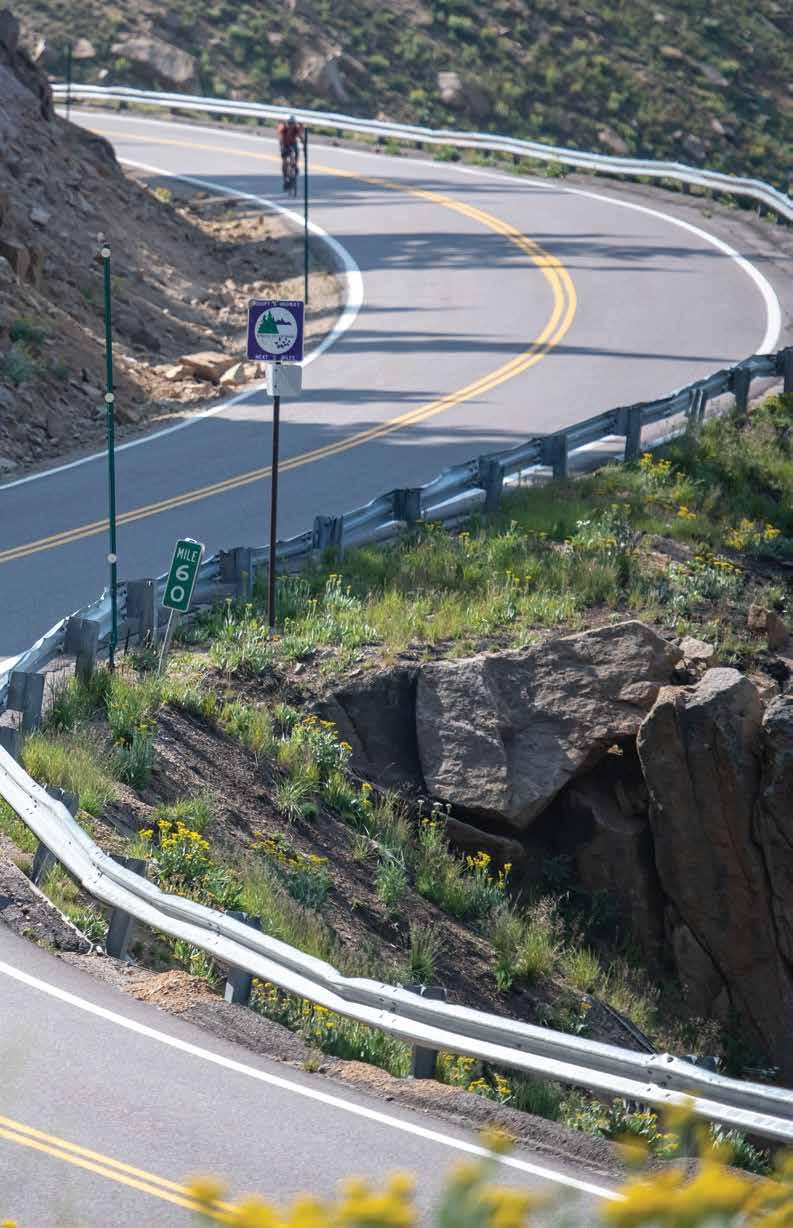
our team presentation at the Boulder Theater. It was very special—it was a true American team.
For this year’s Tour de France, I’ll be on the motorcycle for all 21 days, interviewing riders, analyzing their pedaling, interviewing directors. I’m equal parts excited and nervous. I’ve been in the studio as a cycling analyst for NBC Sports for nine years, and it took time to feel comfortable doing that job. It’ll be interesting to have a different job inside the race and get that amazing feeling that comes from the cold weather and the people screaming. There’s no scrimmage, and it’s going to be a crazy start in Spain for Day 1. Any time the Tour starts outside France, it usually draws three times the people. It’ll be trial by fire.
Aspen is my downtime between two Grand Tours. My wife joins every year after holding down the fort at home in Greenville, South Carolina, while I’m at the Tour de France. This summer, my former teammate, Tyler Farrar, who’s won a stage in every Grand Tour, is a special guest. It’s a time to wind down, connect with great people, and do some beautiful rides.
122

The Allure of Aspen with Alisa Weilerstein As told to Lindsey Kesel
The cello superstar recalls the Aspen summers that shaped her youth and shares how her lifelong kinship with the Aspen Music Festival and School has come full circle.
I spent every summer of my childhood in Aspen. In my mind, Aspen is green. It’s wildflowers, Cathedral Lake, driving up to the Maroon Bells afterhours to look at the stars. I thought it was completely normal to spend a few weeks each year hiking beautiful mountains and making amazing friends. I would go to two concerts a day, eat at Paradise Bakery, and walk on the pedestrian mall and watch jugglers and all the wonderful wildlife. Once I saw a couple of bears walking across the street—that’s something you see in Aspen and not many other places.
Images by Mike Grittani, Eduardus Lee, Elle Logan, Carlin Ma, Tessa Nojaim, and Graham Northrup
124
Cellist Alisa Weilerstein performs with the National Youth Orchestra in Amsterdam in 2022.

My parents were teachers and performers at the Aspen Music Festival and School. They were incredible musicians in their own right. They practiced every morning of my life, and they did that in Aspen, too. I was practicing a lot in the practice rooms on campus, then I became a formal student at age 13. I started playing professionally when I was 14 years old, performing as a soloist with orchestras around the world.
In regular school, I always felt like a bit of a misfit. Summer in Aspen was a time to find my people. The relationships with my teachers and my peers are ones I still have to this day. I’m 41 now and still thinking about the friends I made when I was 13.
I moved through very important milestones as a kid and as a teenager in Aspen. One summer I was placed in the opera orchestra, which meant that I was sitting in the opera pit and learning the two wonderful operas The Magic Flute and La traviata . Playing opera is not something I ever expected to do, and I don’t do it anymore, but
seeing how it all works and getting to know the conductors and how they relate to the singers was really fascinating. The following year I played Mahler’s Ninth Symphony inside the orchestra. I was already playing as a soloist around the world, but being inside the opera orchestra and the bigger orchestra—that was mind-blowing.
If it was a particularly wonderful day, I would take my cello out to practice at the Roaring Fork River nearby, where I could hear the rapids and the birds and look at the mountains. There’s also another side to Aspen—the violent storms. Many a concert has been interrupted by a massive thunderstorm, and because of the tent, you can really hear it. If you come to an intimate spot in a concert, it’s possible that the sound could get completely wiped out by Mother Nature!
My last year as a student in Aspen, I was 18. Eight years later, when I was 26 years old, I returned to the festival as a guest artist. I gave a masterclass, played a concerto with the festival
126
Alisa Weilerstein previews the first installments of her multi-year solo cello performance series, Fragments, at Harris Concert Hall in Aspen in 2022.
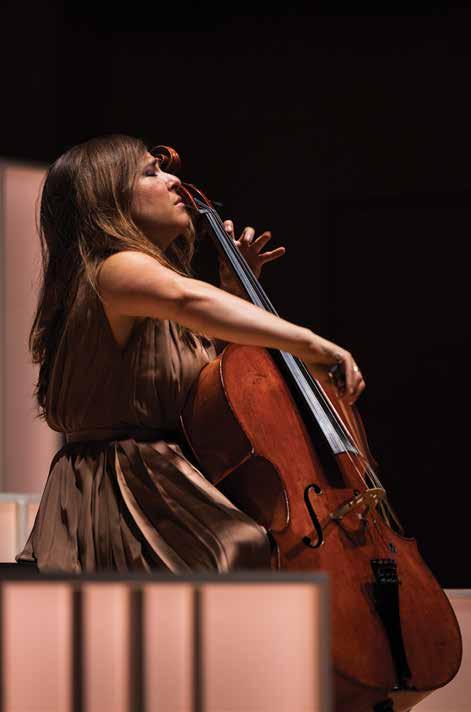

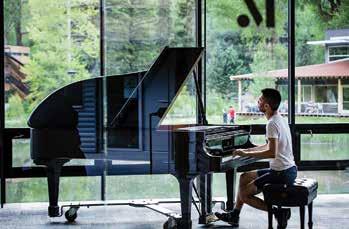

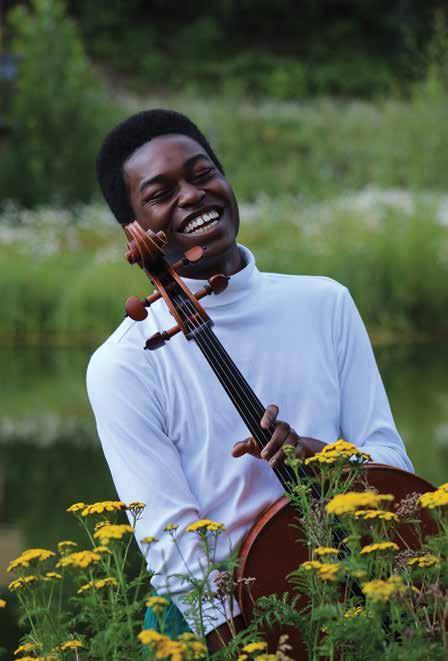
128
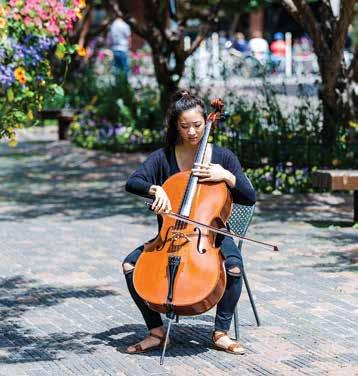
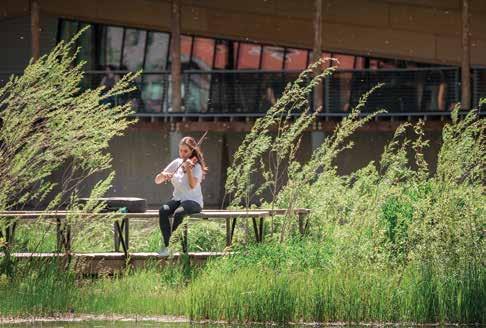
Students from around the world descend upon Aspen for the hundreds of classical music events and programs hosted by the Aspen Music Festival and School each summer.
orchestra, and played some chamber music. I’ve been coming pretty much every year since then. Both of my babies—I have a 7-year-old and a 14-month-old—spent the first summer of their lives in Aspen. Taking them to the Maroon Bells as small babies was like a benediction of sorts. Right around 6 p.m., when the light is starting to soften, it’s just so moving.
My favorite things about Aspen are the festival, the people, and the marrying of nature, music, and joy. I’m excited to bring my children back. I’ll be working with my husband this summer—he’s conducting the orchestra—so it will be nice to be there together. It’s a really beautiful thing to bring family, past and present, together.
130
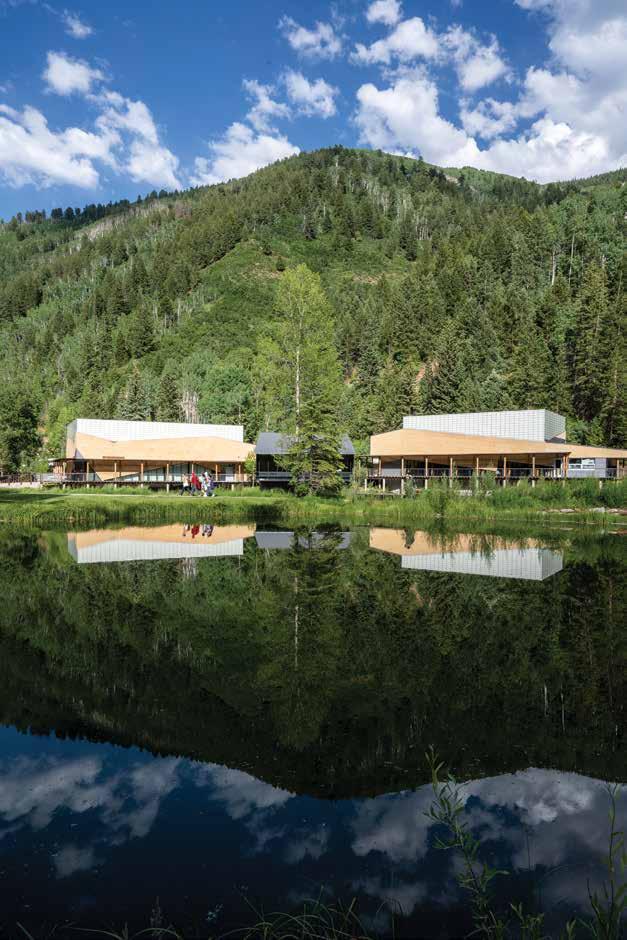 The picturesque Bucksbaum Campus houses the Aspen Music Festival and School’s state-of-the-art practice facilities against a backdrop of pastoral fields, ponds, and aspen groves.
The picturesque Bucksbaum Campus houses the Aspen Music Festival and School’s state-of-the-art practice facilities against a backdrop of pastoral fields, ponds, and aspen groves.
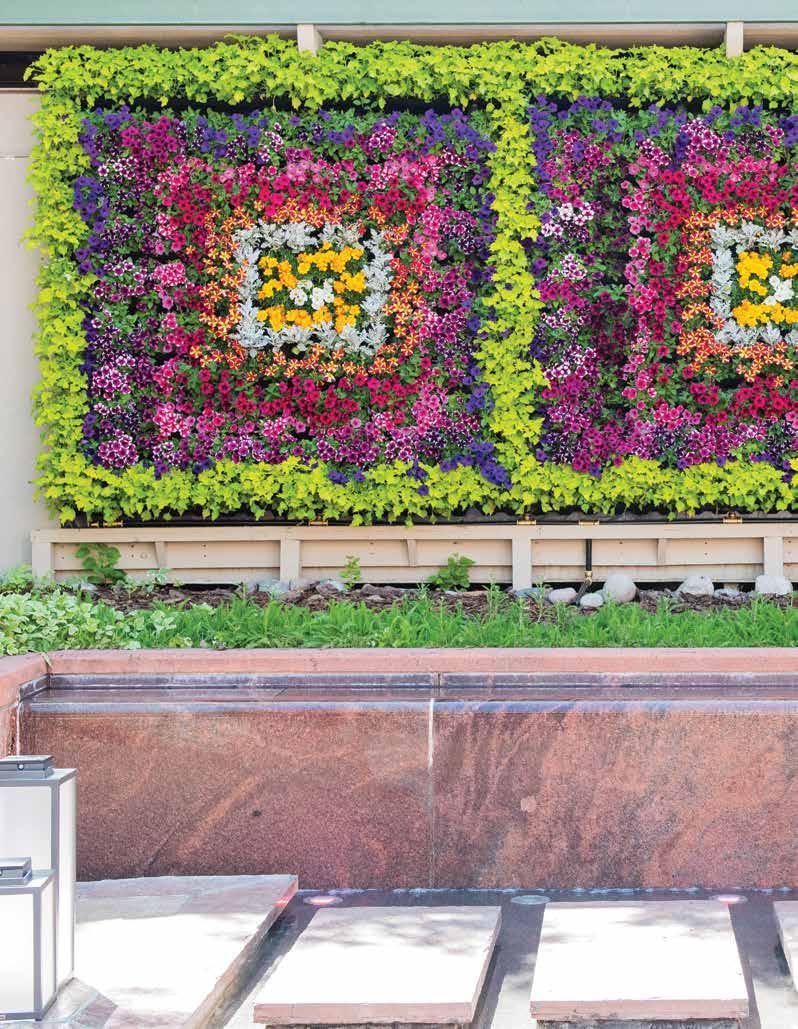 A sign of summer at The Nell.
A sign of summer at The Nell.
132
Image by Jamie Jaye Fletcher

Return
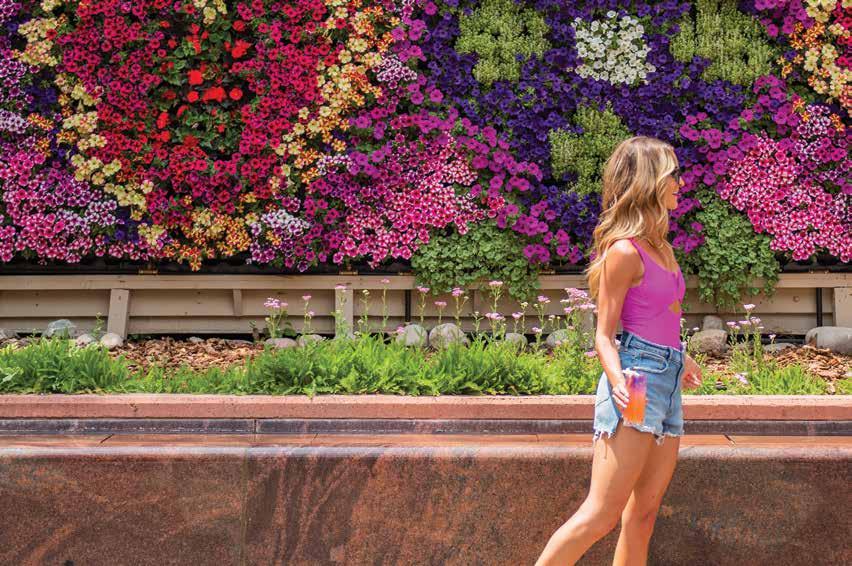
In summertime, The Little Nell offers weekly tours of its colorful gardens, which include edible herbs and flowers used in the hotel’s seasonal food and beverage offerings.
Courtesy of Busy Beavers Gardening, The Little Nell’s summer gardens are a feast for the senses.
Every summer, The Little Nell’s gardens come to life with perennials and annuals framing the hotel—from the living wall punctuating the pool courtyard, to the front façade with its hanging baskets, to the pots of lavender on the patio at Ajax Tavern. For more than a decade, Busy Beavers Gardening (BBG), owned by Arabella Beavers-Kaplansky and Jason Beavers, has tended to the landscaping at The Nell, working in tandem with a talented team. Arabella’s experience in English gardening and excellent knowledge of plant varietals complement Jason’s extensive background in business operations, garden installation, and maintenance.
BBG begins preparation throughout the grounds in early May, manages the property all summer, and then puts everything to bed in late September until the next summer season. As part of its process, the company focuses on sustainable gardening practices, using no chemical pesticides to encourage bees, butterflies, and hummingbirds to come and feed. The company utilizes the “right plant, right place” technique to create the best-growing habitat, and it always buys local, purchasing flowers and plants grown nearby in Paonia, Colorado.
A highlight is the living wall suspended over the pool, a colorful vertical garden that displays a new theme each year. This summer, the garden features an “Arc of Life” theme, with a sunset and vibrant sunray design. This year, you’ll also see an expanded on-site chef’s garden, with herbs such as chives, dill, basil, thyme, and mint for use in the hotel’s food and beverage offerings, as well as edible flowers to decorate plates.
Learn more in person by joining Arabella for her weekly garden tours offered on Fridays at 4 p.m. Garden tours are complimentary and open to the public—no need to be a hotel guest to take part—enabling you to pick up tips on highaltitude gardening and more.
Fabulous Florals Image by Jamie Jaye Fletcher
135
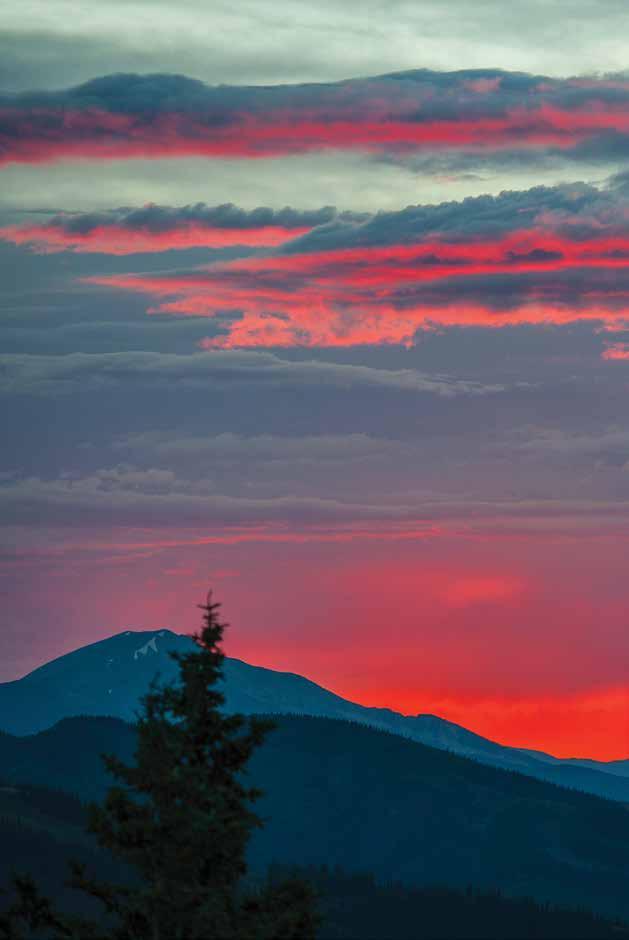
With no shortage of recreation or stunning landscapes to discover, it’s never a dull moment for photographer and adventure and ski concierge Steve Goff.
Meet Steve Goff, adventure concierge by summer, ski concierge by winter, and photographer year round.
My first camera and photography experience was in 1998 on a trip to Verbier, Switzerland, where some friends and I had the opportunity to ski for 10 days. My parents bought me a Canon Elph point-and-shoot for the trip, and I documented everything from sweeping views of the Alps to the fondue. It birthed a new passion for me, and I started taking workshops to hone my skills. When I moved to Aspen in 2009, I discovered a way to pair my passions for people and hospitality with my work at The Little Nell as an adventure concierge and a photographer. I started taking photos of nature and landscapes on our outings, which then led to portraits and has since evolved into capturing families, proposals, weddings, and more.
 Picture Perfect
Images by Steve Goff
Picture Perfect
Images by Steve Goff
137

My favorite time to photograph in the Aspen area is during peak fall foliage, when the seasons change from autumn to winter. When there’s a good chance of fresh snow in the higher elevations, I’ll wake up before dawn and drive up Castle Creek Road to capture these magical moments.
Current camera equipment:
(2) Nikon D850 DSLR bodies
(1) Nikon Z7 II mirrorless iPhone 14 Pro Max
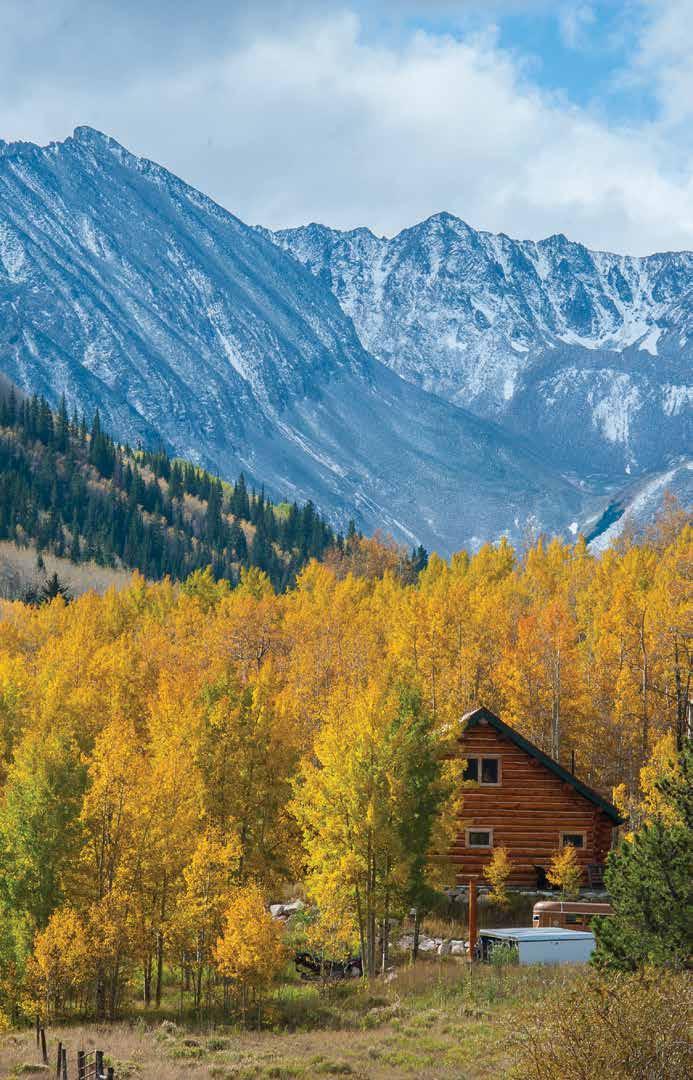
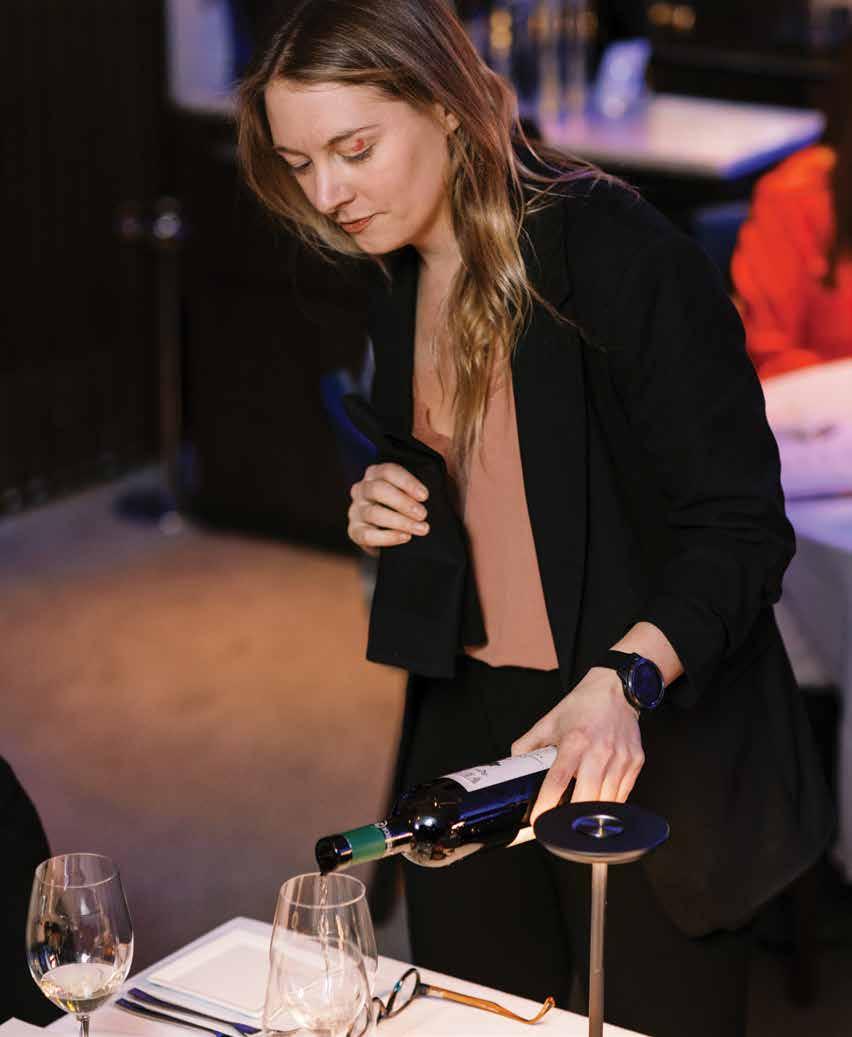 Sommelier Rachael Liggett-Draper was drawn to The Little Nell for its worldclass wine program and unparalleled access to the outdoors.
Sommelier Rachael Liggett-Draper was drawn to The Little Nell for its worldclass wine program and unparalleled access to the outdoors.
Sommelier Rachael Liggett-Draper recommends singular Champagnes from The Nell’s vast wine list.
“It’s every sommelier’s dream to curate a list of the world’s best Champagnes and also have the kind of clientele who will appreciate them,” says sommelier Rachael Liggett-Draper about the energetic and effervescent sparkling wines found in Element 47 at The Little Nell. It is an opportunity that few places can offer.
Liggett-Draper came to Aspen in 2021 after working the floor in such stellar Vail restaurants as La Tour and Sweet Basil. An advanced sommelier in the Court of Master Sommeliers—she’s on track to take the Masters exam this year—she was ready for the next step in her career.
“I knew I wanted to work with a really deep wine list, and most of those tend to be on the coasts, in New York or San Francisco,” Liggett-Draper says. “But there was one wine list that I didn’t have to leave the Rocky Mountains for, and that was here at The Little Nell.” With more than 3,000 selections covering 118 pages, The Nell’s vast wine list is among the world’s most revered, and for the avid mountain biker, the location remains irresistible for its proximity to the mountains.
A self-proclaimed Francophile, Liggett-Draper naturally loves Champagne for its versatility and personality. Be it niche grower Champagne or one from the larger domaines, The Nell’s list covers the region and also features unique and impressive offerings by the glass. “Each year we do a collaboration with a Champagne house to create a Little Nell cuvée,” Liggett-Draper says. “This past year’s wine was Vilmart & Cie, Champagne blend, Little Nell cuvée brut, which was a growers Champagne.”
At right, Liggett-Draper recommends three wines from The Nell that she feels are both delicious and reflect the sustainability movement of the Champagne region. “In the last couple of years, I’ve seen Champagne producers making improvements in sustainable practices and decisions,” Liggett-Draper says. “We’re seeing a lot of regenerative farming, and growers are moving toward organic or biodynamic certifications. We’re seeing the larger Champagne houses move that way, too.”
Ruinart Rosé, NV
Liggett-Draper suggests this bright, zippy, and refreshing offering from the world’s first Champagne house, established by Nicolas Ruinart in 1729. “I don’t think enough people drink rosé Champagne,” she says. “I like this wine with a weightier dish—something like a steak tartare because of the structure that the pinot noir gives to the bubbles.”
Pascal Doquet Coeur de Terroir Le Mesnil Sur Oger, 2005
This small producer makes wines from sustainably grown grapes from top terroir in the Côte des Blancs. “People don’t always get the chance to drink Champagne with a little age,” Liggett-Draper says. “Doquet’s wines are rich with complex aromas of brioche, toast, and caramel. A great option for Krug lovers.”
Gaston Chiquet Special Club, 2014
The “Special Club” designation of the Club Trésors represents the highest tier classification that a grower Champagne can achieve. “Look for wines with this label to ensure an amazing bottle with value,” LiggettDraper says. This wine, made in 100 percent stainless steel, “hits the sweet spot when paired with a raw crudo or sashimi. The fresh green apple and citrus notes make for an energetic food pairing, but the complexity of the vintage age make it stunning on its own.”
A
Sommelier Dreams of Bubbles
Text by Kelly J. Hayes
Image by Megan Wynn
141
Mixologist
Andy Zurita shares one of his favorite summer cocktails from Element 47.
Ingredients
1.5 ounces Tito’s vodka
0.25 ounces Mr. Black cold brew coffee liqueur
0.25 ounces Amaretto liqueur
1 ounce pineapple juice
1 ounce espresso
Directions
1. Combine ingredients in a cocktail shaker with ice.
2. Shake thoroughly and strain into a cocktail glass.
3. Top with a few coffee beans and serve.
A favorite activity at The Little Nell is enjoying a refreshing cocktail after a day exploring Aspen. In summertime, The Little Nell’s mixologist, Andy Zurita, recommends The Scorpio, a cocktail with personal significance that he crafted for the Element 47 bar menu. “It’s purely the perfect combination of summer flavors that remind me of my childhood in the Caribbean,” Zurita says. “The espresso martini is one of the most popular cocktails in the world, and I wanted to create a twist on a classic, with a hint of my home.”
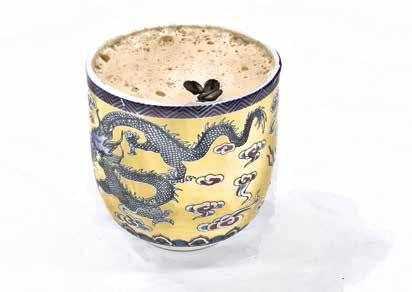 Summer Sips
Image courtesy of The Little Nell
Summer Sips
Image courtesy of The Little Nell
142
Rachel Lynn Chicago

This female-owned, designed, and operated jewelry brand focuses on timeless, fashion-forward jewelry that will last a lifetime and become heirlooms to future generations.
The in-house designs are created for women well traveled and with a keen sense of style—women who want something rare and produced in limited quantities. It’s easy to find multiple pieces you’ll want to acquire from the brand’s wide range of exquisite avant garde fine jewelry. Rachel Lynn Chicago also has a beautiful selection of beaded jewelry that is handmade in Aspen, offering locals and visitors a place to find affordable gifts and treasures alike.
Rachel Lynn Chicago Fine Jewelry was established in 2008 and is a limitedproduction jewelry brand located in
the heart of Aspen.
Rachel Lynn Chicago’s mission is always to create a warm and inviting environment for its clients. Add this special Aspen boutique to your shopping list to feel the love, care, and expertise offered in its intimate Aspen retail space and see why this is the place “Where the Women of Aspen Treat Themselves.”
Follow on social media @rachellynnchicago Visit the website to view the brand’s current offerings: rachellynnchicago.com
Open Daily 11 a.m.–5 p.m.
103 S. Mill Street at the corner of Main and Mill Street, across from the historic Hotel Jerome.
Get to know Mike Kaplan, who retired in April 2023 after 30 years at Aspen Skiing Company, the past 17 as CEO.
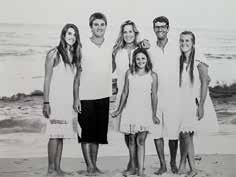
Where did you grow up?
Highland Park, Illinois, the suburbs of Chicago.
Where did you go to school and what did you study?
I went to high school at Stratton Mountain School, where I studied skiing! Then I attended CU Boulder, where I studied skiing (and International Affairs), and earned my MBA from the University of Denver, where I also studied skiing!
What was your career path at Aspen Skiing Company?
I was in ski school management from 1993 to 1999, became VP of operations in 1999, then took on the role of COO in July 2005 and CEO in November 2006
What did you love most about your time with Aspen Skiing Company?
Besides skiing, the people I got to interact with. That includes the employees—both those I’ve known and worked alongside for decades and newer team members just beginning their careers— and the many guests I’ve gotten to know on chairlift rides or otherwise developed relationships with over the years. Many of these friendships have lasted a lifetime, and I hope they will continue beyond my tenure as CEO.
Which talent would you most like to have?
I wish I could play the guitar, sing, and speak Spanish. I would drive the Baja California peninsula, camping, surfing, and strumming my way down to Cabo—but get back here in time for winter!
Where would you most like to live?
Where I do now: Aspen.
What is your most treasured possession?
My Ibis Ripley mountain bike.
What is your idea of perfect happiness?
I don’t believe in “perfect,” and I think happiness is a practice, not a feeling. Dedicating my life to pursuing my passion—life in the mountains—and sharing and sustaining it, is incredibly rewarding and all consuming. I feel fulfilled for having had this opportunity and am excited about what’s to come.
When and where were you happiest?
Right here and right now. Looking back, if I had to do it over again, I’d be right where I am.
Image courtesy of Mike and Laura Kaplan The Last Word with Mike Kaplan
144
Mike Kaplan and family, circa 2014.

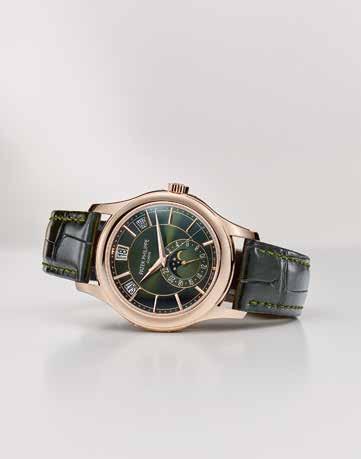



































































































 Henning Rahm General Manager
Henning Rahm General Manager







 The hidden lands of Beyul Retreat.
The hidden lands of Beyul Retreat.

 Text by Amanda Rae
Images by Alexis Ahrling, Brandon Brightside, Andy Culp, Spencer
Hansen, John Felix Shaw, Sammy Steen, and Summit Series Paradise
Text by Amanda Rae
Images by Alexis Ahrling, Brandon Brightside, Andy Culp, Spencer
Hansen, John Felix Shaw, Sammy Steen, and Summit Series Paradise




























 Nick Fouquet’s tools of the trade.
Nick Fouquet’s tools of the trade.

 Text by Katie Shapiro
Text by Katie Shapiro






 Above, a hat is steamed into shape at Kemo Sabe. On opposite page, Susan Carrolan works out of her hattery in the Aspen Airport Business Center.
Above, a hat is steamed into shape at Kemo Sabe. On opposite page, Susan Carrolan works out of her hattery in the Aspen Airport Business Center.




 Miami artist Cornelius Tulloch spent five weeks at Anderson Ranch as an artist in residence in spring 2023.
Miami artist Cornelius Tulloch spent five weeks at Anderson Ranch as an artist in residence in spring 2023.







 This carved oil painting on birch plywood by Anderson Ranch visiting artist Ricky Armendariz depicts Spanish Baroque painter and former slave Juan de Pareja.
This carved oil painting on birch plywood by Anderson Ranch visiting artist Ricky Armendariz depicts Spanish Baroque painter and former slave Juan de Pareja.
 Brooklyn artist Kemar Keanu Wynter is pictured at Anderson Ranch Arts Center during his time as an artist in residence in 2022.
Brooklyn artist Kemar Keanu Wynter is pictured at Anderson Ranch Arts Center during his time as an artist in residence in 2022.



 Text by Kelly J. Hayes
Text by Kelly J. Hayes




































 Writer Andrew Travers is the Penner Manager of Educational Programs at the Aspen Institute’s Resnick Center for Herbert Bayer Studies.
Writer Andrew Travers is the Penner Manager of Educational Programs at the Aspen Institute’s Resnick Center for Herbert Bayer Studies.
 A taste of terroir.
A taste of terroir.




 Jimerson takes part in a blind tasting with friend and fellow sommelier Chris Dunaway, wine director at The Little Nell.
Jimerson takes part in a blind tasting with friend and fellow sommelier Chris Dunaway, wine director at The Little Nell.





















 The picturesque Bucksbaum Campus houses the Aspen Music Festival and School’s state-of-the-art practice facilities against a backdrop of pastoral fields, ponds, and aspen groves.
The picturesque Bucksbaum Campus houses the Aspen Music Festival and School’s state-of-the-art practice facilities against a backdrop of pastoral fields, ponds, and aspen groves.
 A sign of summer at The Nell.
A sign of summer at The Nell.



 Picture Perfect
Images by Steve Goff
Picture Perfect
Images by Steve Goff


 Sommelier Rachael Liggett-Draper was drawn to The Little Nell for its worldclass wine program and unparalleled access to the outdoors.
Sommelier Rachael Liggett-Draper was drawn to The Little Nell for its worldclass wine program and unparalleled access to the outdoors.
 Summer Sips
Image courtesy of The Little Nell
Summer Sips
Image courtesy of The Little Nell



